Bloomfield Science Museum, Jerusalem – Visitors Guide
Bloomfield Science Museum is a lovely attraction for families. There are many hands-on exhibitions and workshops.
Note: for similar attractions, check out Science Museums in Israel.
Table of Contents
- 1 Map
- 2 Opening Hours
- 3 Entrance Fee
- 4 Coupons and Discounts
- 5 Parking
- 6 Events and Workshops
- 7 What Ages is Bloomfield Science Museum Suited for?
- 8 At Bloomfield Science Museum
- 9 Similar Attractions
- 10 Summary
Map
Bloomfield Science Museum is located near other museums in the city, and its address is Sderot HaMuze’onim 3, Jerusalem.
Directions for drivers: Link to Waze and Link to Google Maps
Directions for public transport: Link to Moovit
Interactive map of the area:
Opening Hours
Sunday: Closed
Monday – Thursday: 10:00 – 18:00
Friday: 10:00 – 14:00
Saturday: 10:00 – 16:00
Entrance Fee
Adult/child (5 years old and older): 50 NIS
Children under 5: free
Student, soldier, police officer, disabled visitor: 40 NIS
Senior: 25 NIS
Family ticket: 180 NIS.
We purchased tickets at the museum entrance. But you can also buy tickets over the phone.
Notes:
- Opening hours and ticket prices were updated in December 2022. In any case, recheck the official site before visiting.
- Entrance fees during events will be higher.
Coupons and Discounts
You can find different coupons online. And if your credit card does not have relevant offerings, you can purchase through cpnclub. They offer about a 15% discount.
Parking
Parking in many regions of Jerusalem can be problematic. There is free parking in front of the Bloomfield Science Museum, but it is a small parking lot (about two dozen spaces). You can also park on the nearby street (blue and white curbs), but there are few spaces. Thus, my solution was simple: come early. Or, more specifically, come toward the museum’s opening.
Events and Workshops
Another tip is to check the official website for different events and workshops. During our visit, we participated in one free class. We also saw another paid course, but since we were not aware of it taking place, we have not bought tickets in advance.
What Ages is Bloomfield Science Museum Suited for?
The smaller the children, the less they will understand. It may be why children under five years old enter for free. But, I think both children (except babies) and adults can enjoy Bloomfield Science Museum. Instead of looking at the age, I would suggest checking what exhibitions, events, and workshops are taking place, and if those topics interest you, then go.
At Bloomfield Science Museum
I will tell you about one of our visits in the following section. And though the exhibitions are changing, you will know what to expect.
After parking in front of the museum, we headed toward the entrance. And on our way was saw this sundial.
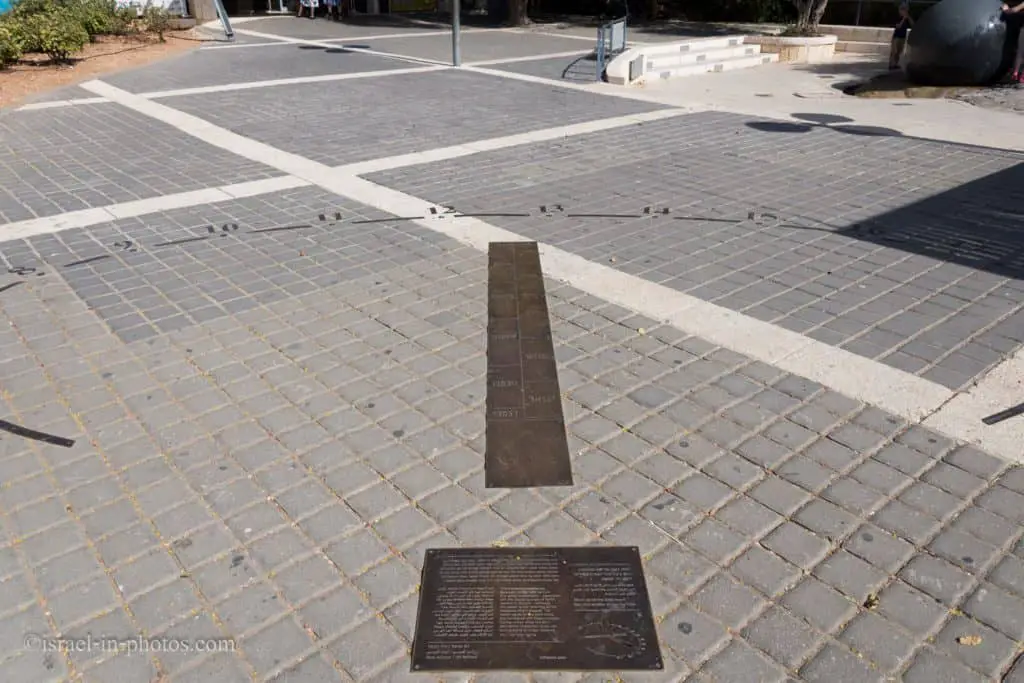
This interactive type of sundial developed in the 16th century and is called the Analemmatic sundial. Your shadow will show the time when you stand on the date border.
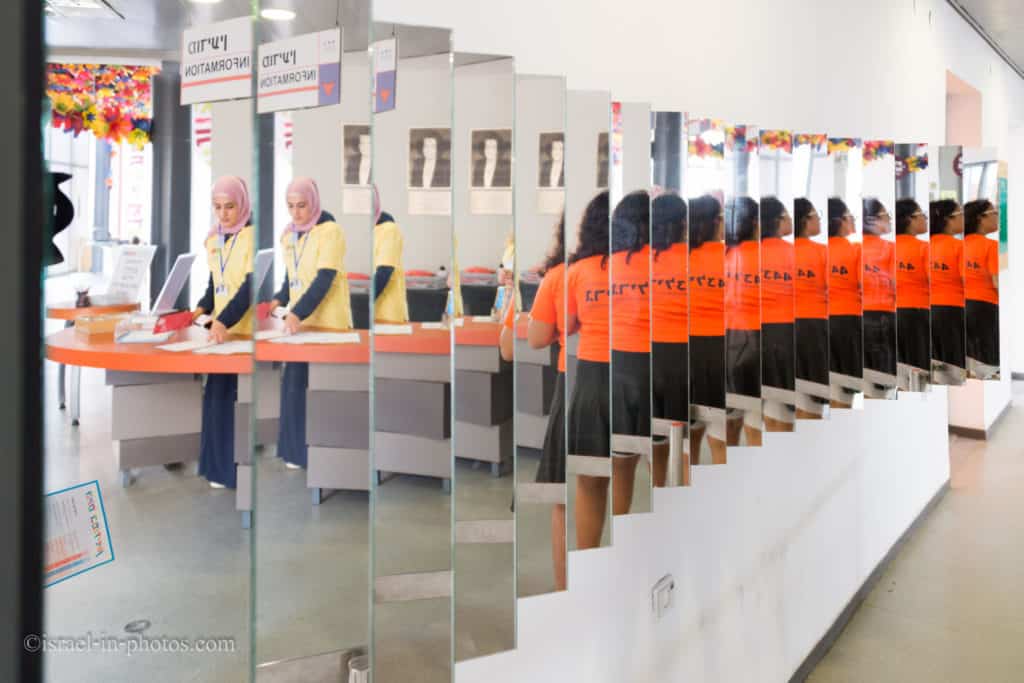
In the reflection of these mirrors, you can see an information stand. You can find general information there and the timetable for the workshops.
Discovering Levers Exhibition
Usually, after long rides, kids want to do something physical. To let off some steam. And the first several rooms, which belong to the discovering levers exhibition, are perfect for this.
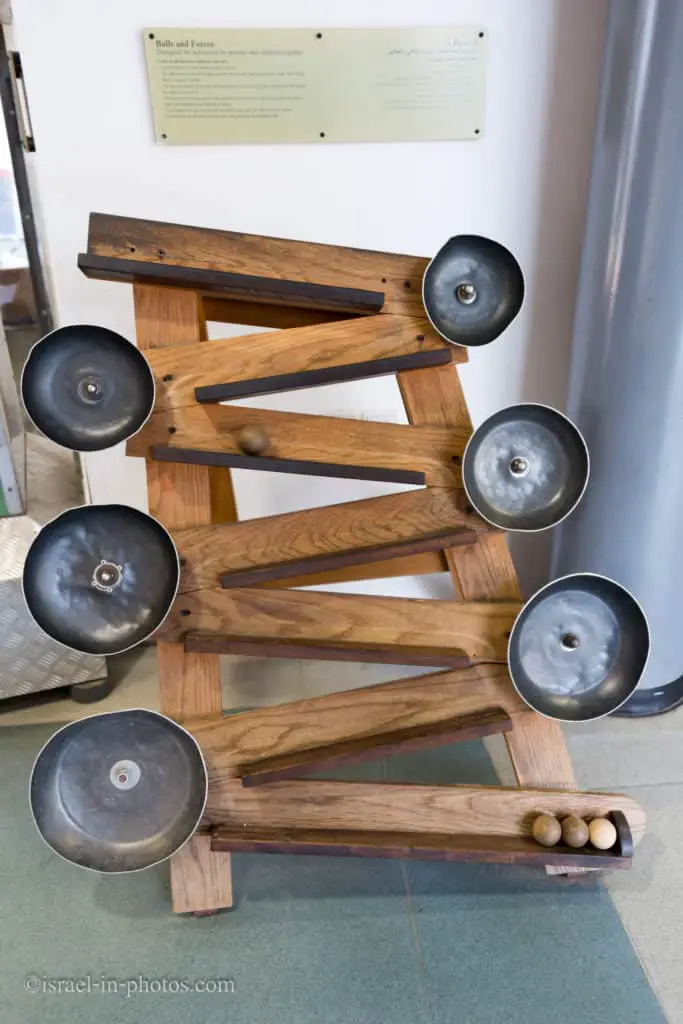
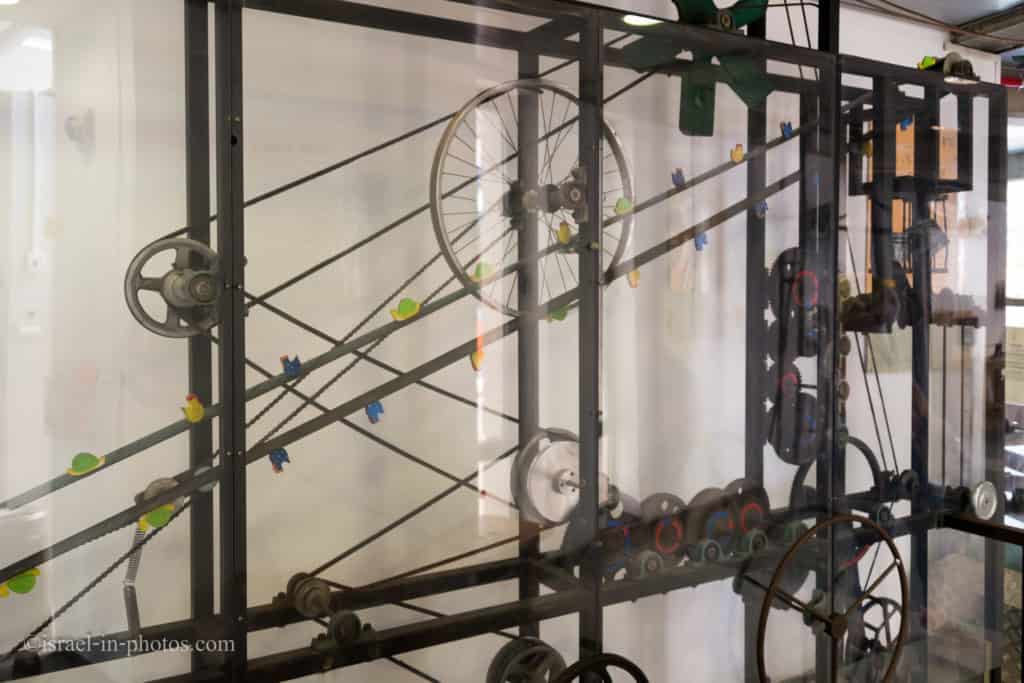
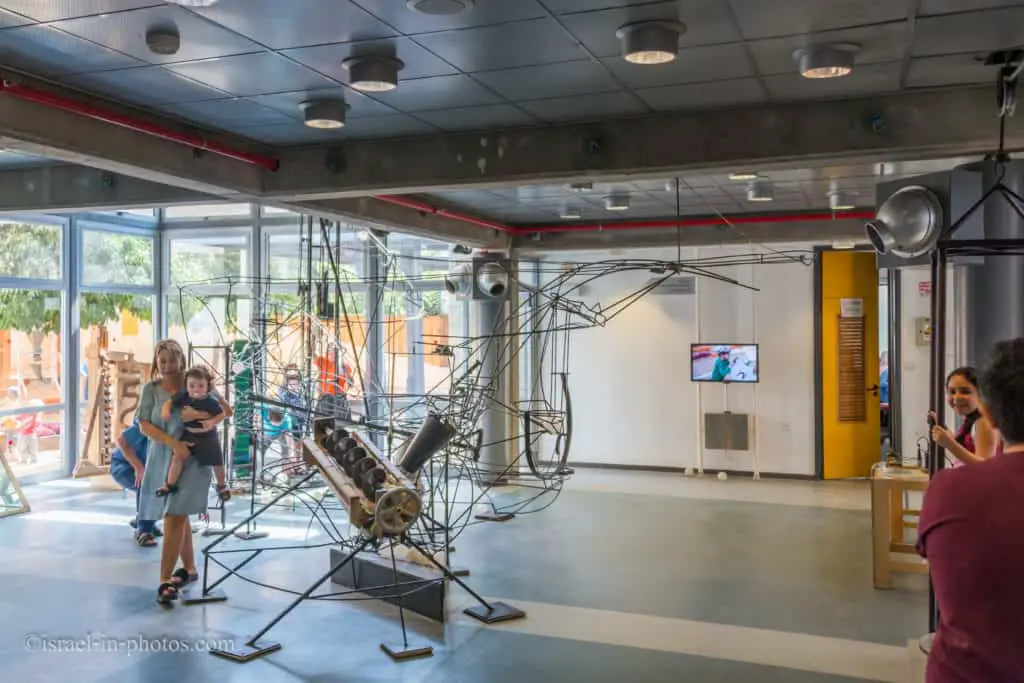
There are different handles kids can rotate, move balls, and run a little. For example, in the photo above, you can see an exhibit that demonstrates different sounds depending on the metal plate size when being hit by a ball.
And this is a pulley lift. It demonstrates how you can easily lift heavy things using pulleys. At the far end, a person stands in the elevator, and you can pull either using a straight rope or a cord that goes through all the pulleys. And while using the straight one, you can barely lift, kids can elevate their parents using the cable that goes through all the pulleys.
You can find several exhibits with balls rolling around the room by the pulley lift. There is also a sand playground outside.
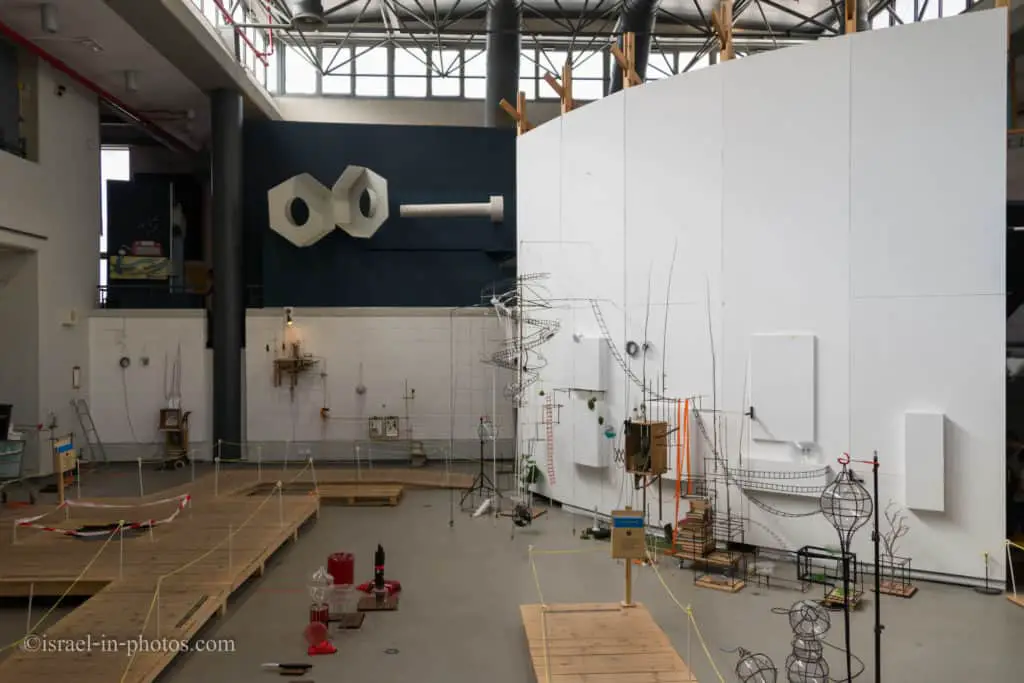
But we headed back towards the hall next to the main entrance since it was time for the sugar workshop.
Sugar Workshop
There were several sugar workshops on that day. Each class was about twenty minutes, and the content was pretty impressive. The problem was they were continually having technical difficulties. First, the microphone did not work. Then it barely worked, but the computer did not work. But I learned several interesting things.
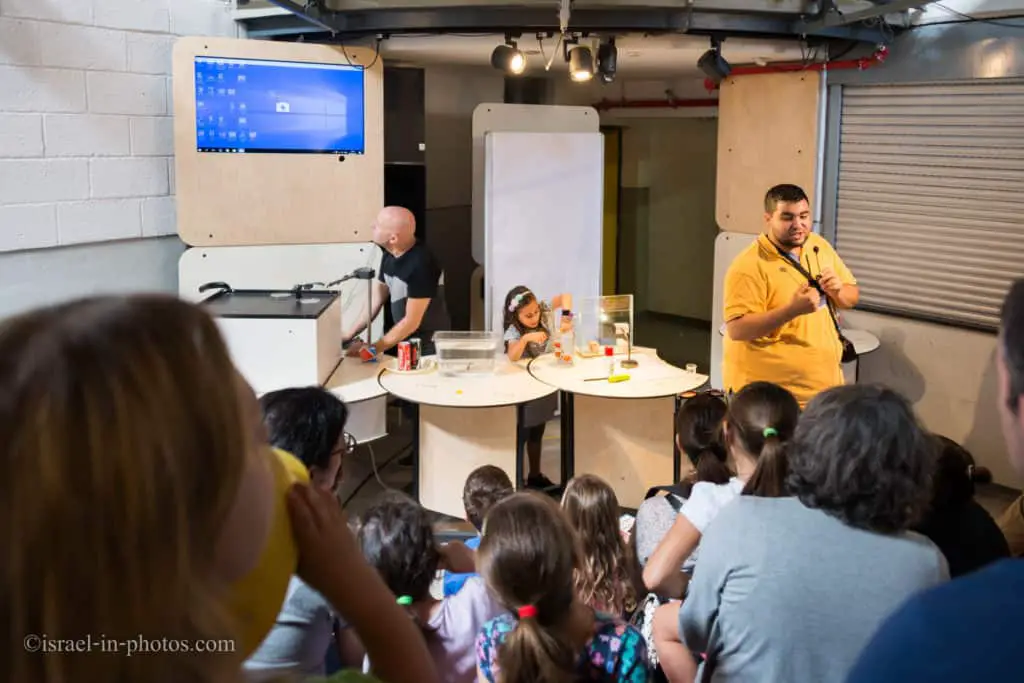
First of all, sugar contains energy. Thus, if you throw sugar on fire, the flame will grow as if you poured gasoline.
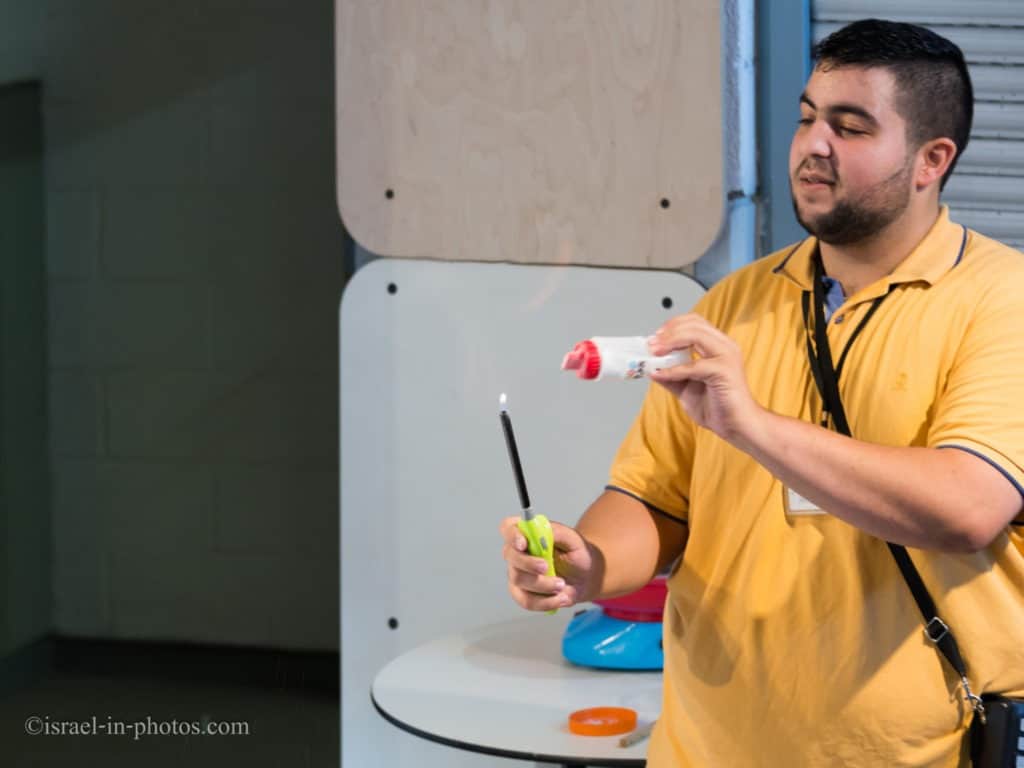
Secondly, water with sugar is denser than regular water. Thus if you put a regular coca cola can in the water, it will drown. But if you put cola zero, the can will float (there is no sugar in zero; instead, there are some sugar replacements).
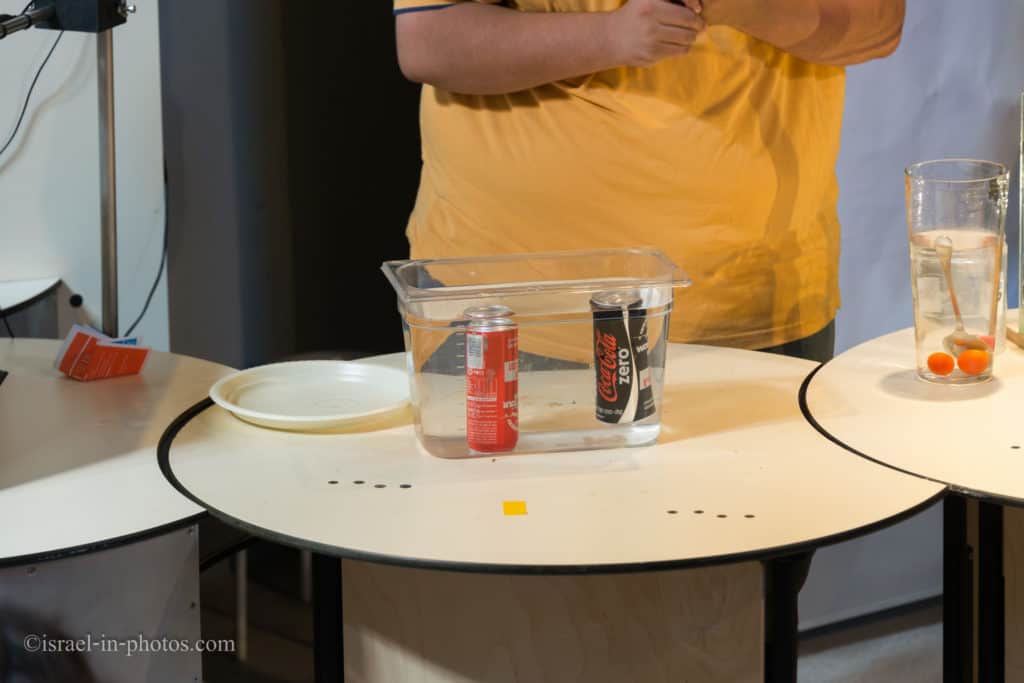
You can all use this method to determine how much sugar there is in a product. Our guide put cherry tomatoes into the water, and they drowned. But then he added some sugar to the water and stirred it. And repeated this process until around seven tablespoons of sugar were added to the water. At this stage, the tomatoes floated. Floating means the amount of sugar in the tomatoes and the water is equal.
We climbed to the second floor when the sugar workshop ended and found an Electricity Exhibition.
Electricity Exhibition
Most of the Bloomfield Science Museum exhibits are interactive and aimed at kids. For example, the solar airplane exhibit had lights next to the ceiling. Using one of the three rotatable mirrors, you can reflect the light to the solar panels of planes. As light hits the solar panels, the aircraft starts to move.
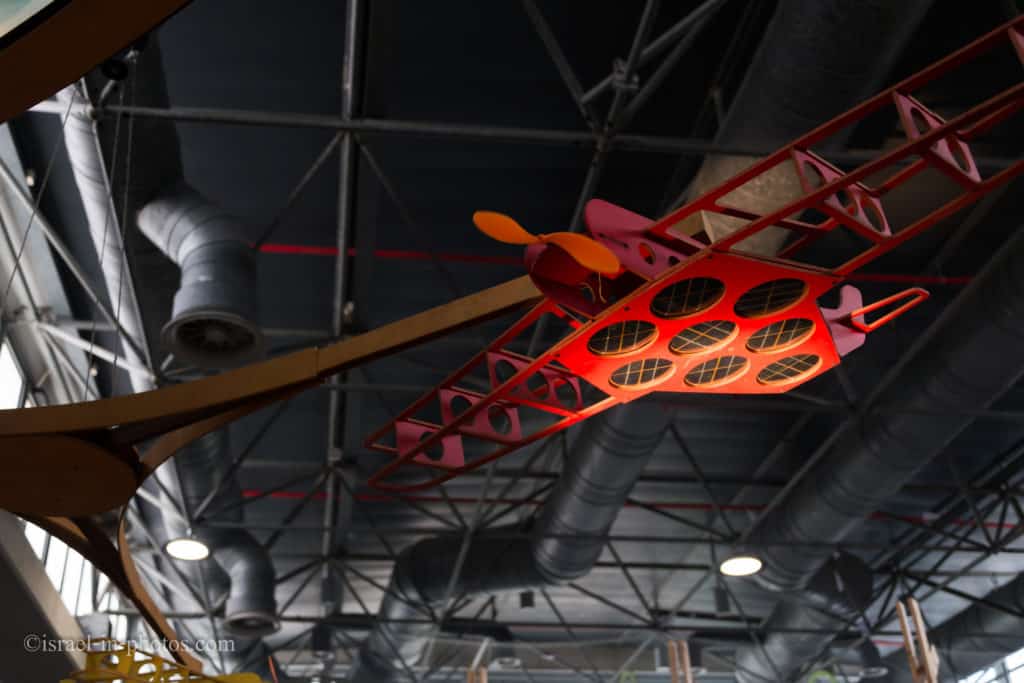
The electricity exhibition was aimed at older kids (my daughter was in the first grade), but she enjoyed the interactivity of it, meaning touching everything :)
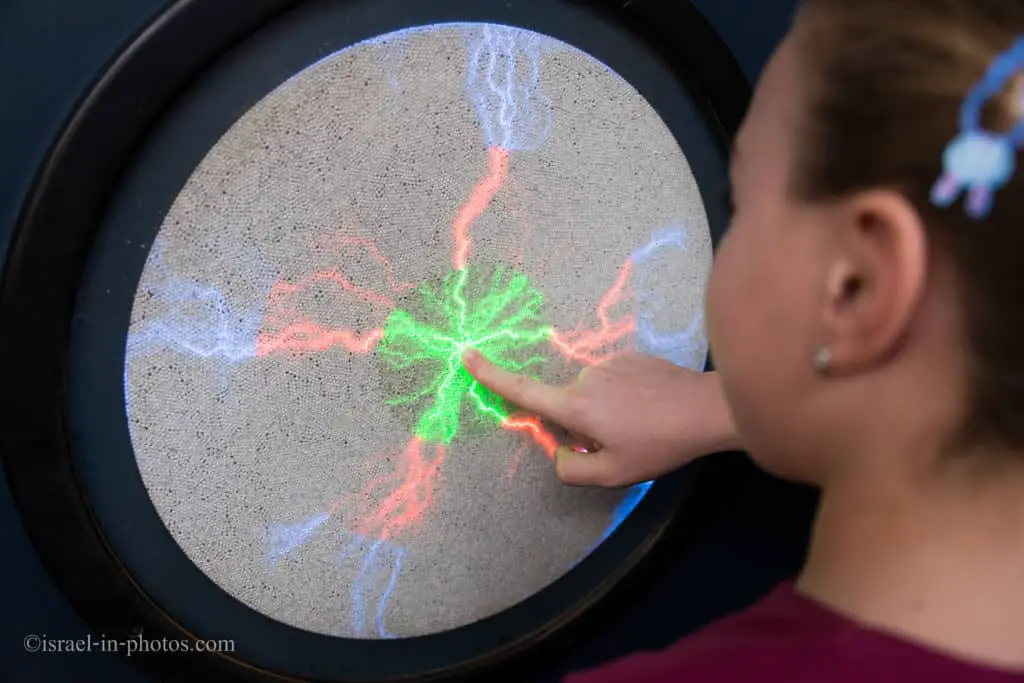
This magnetism exhibit shows what happens to compasses when we turn the electricity on and off.

Another magnet-related exhibit is called “Standing Soldiers.” As you press the button, all pins stick to the sides of the dish.
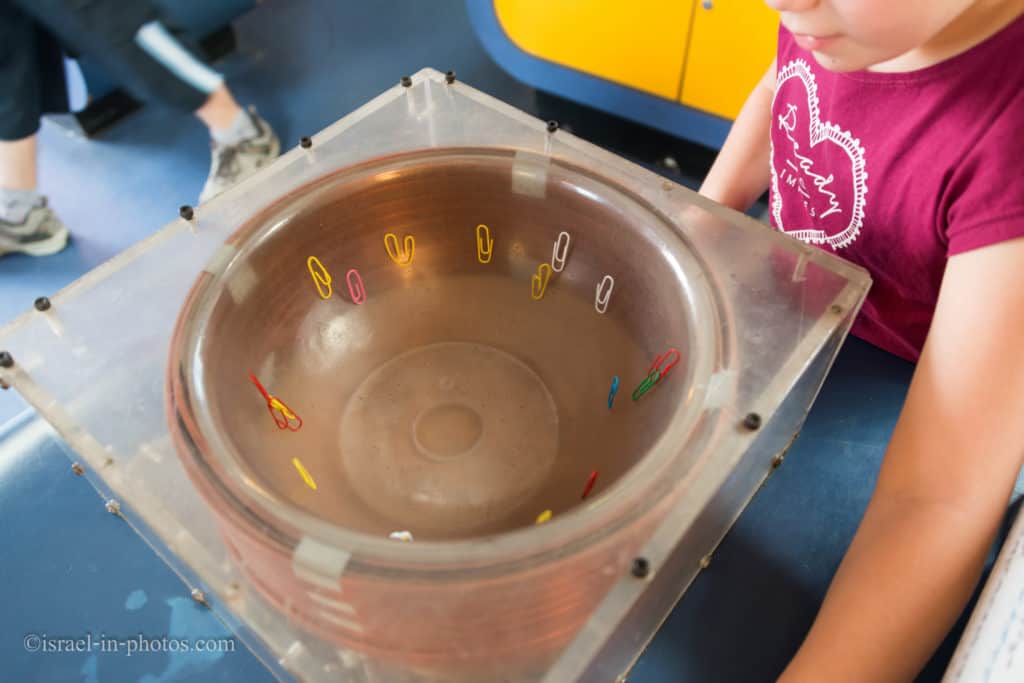
Can there be electricity without power? When holding your hand next to the light bulbs, they turn on.

Illusions Exhibition
Everybody loves illusions, and they are more straightforward for kids to understand.
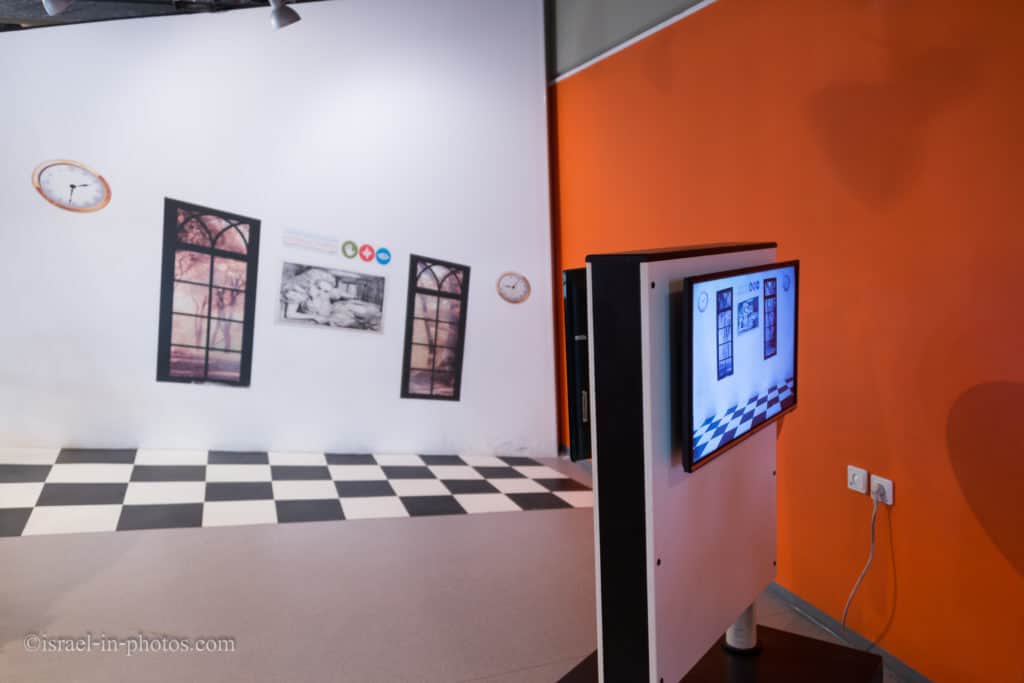
Here is probably one of the most famous optical illusions. Do both items, the left and the right, have the same length?
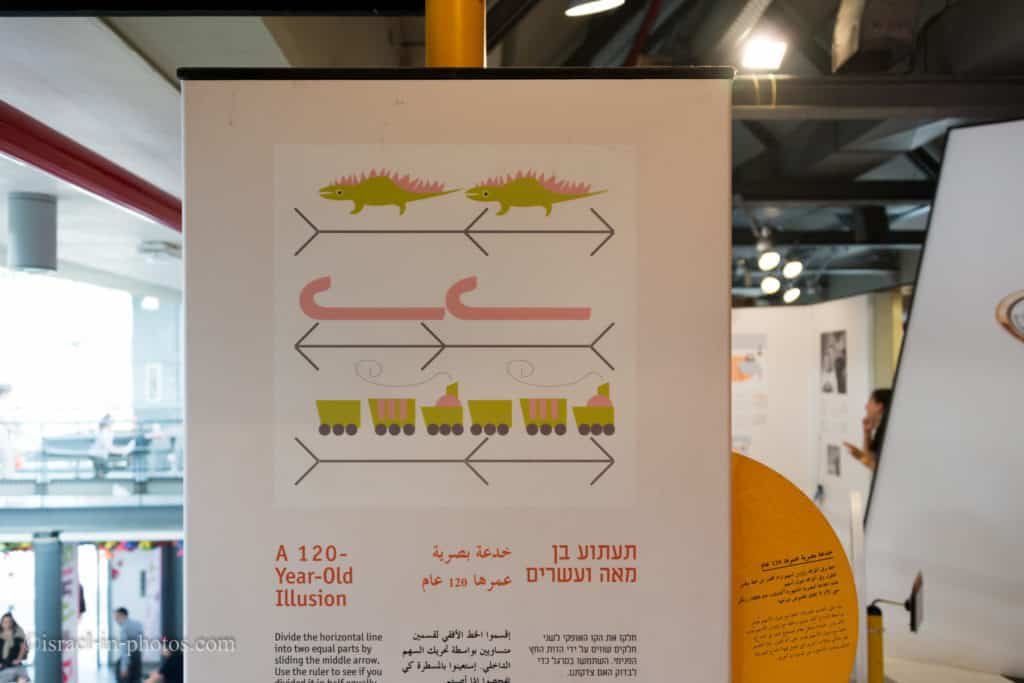
And here are two overlapping images. What do you see?
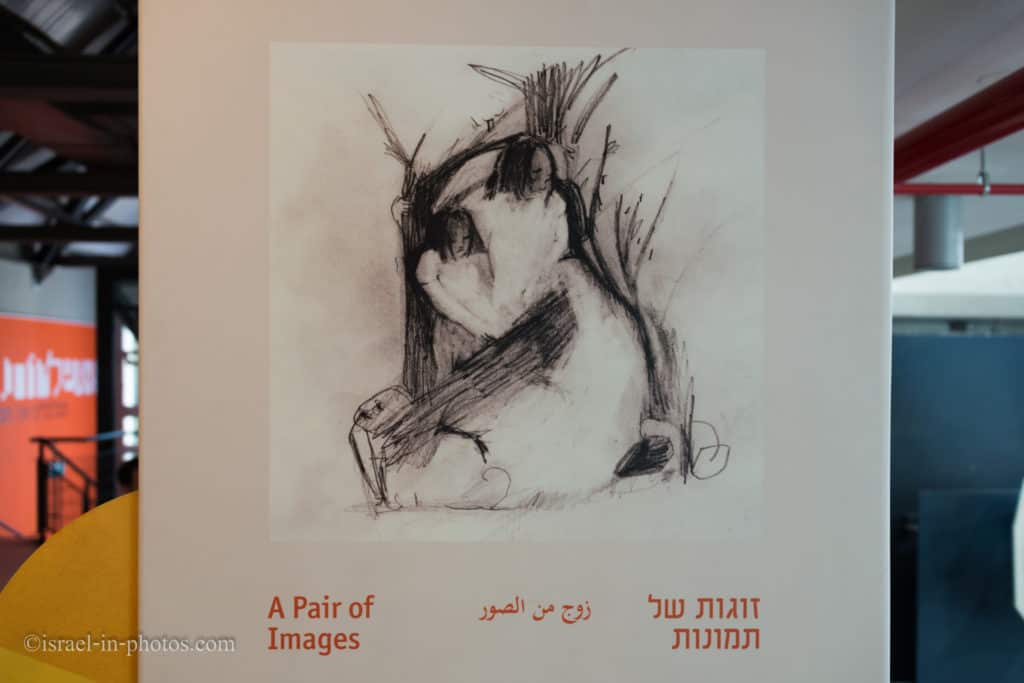

Looking closely at their faces, you will see it is the same.
And, of course, no option illusion exhibition would be complete without the expanding universe exhibit.
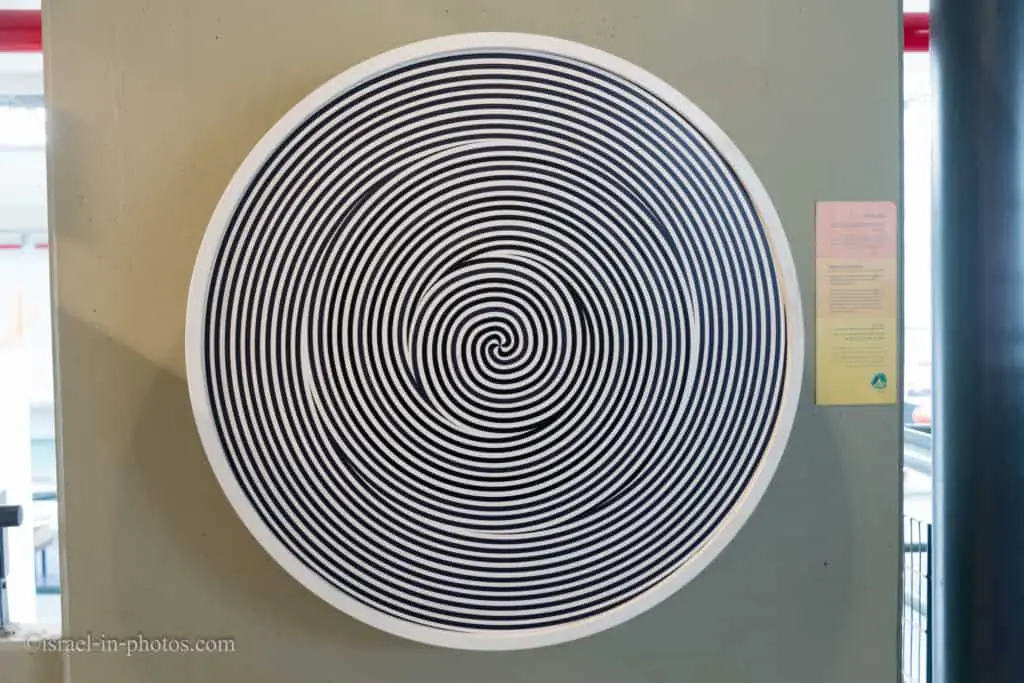
Are you still reading this? I was afraid that I would lose some of the readers after the previous photo :)
Paper Corner
The paper corner, as I called it, had several stands. At one of them, you could launch your paper planes. And at another, kids prepared flowers and could play with the boats.
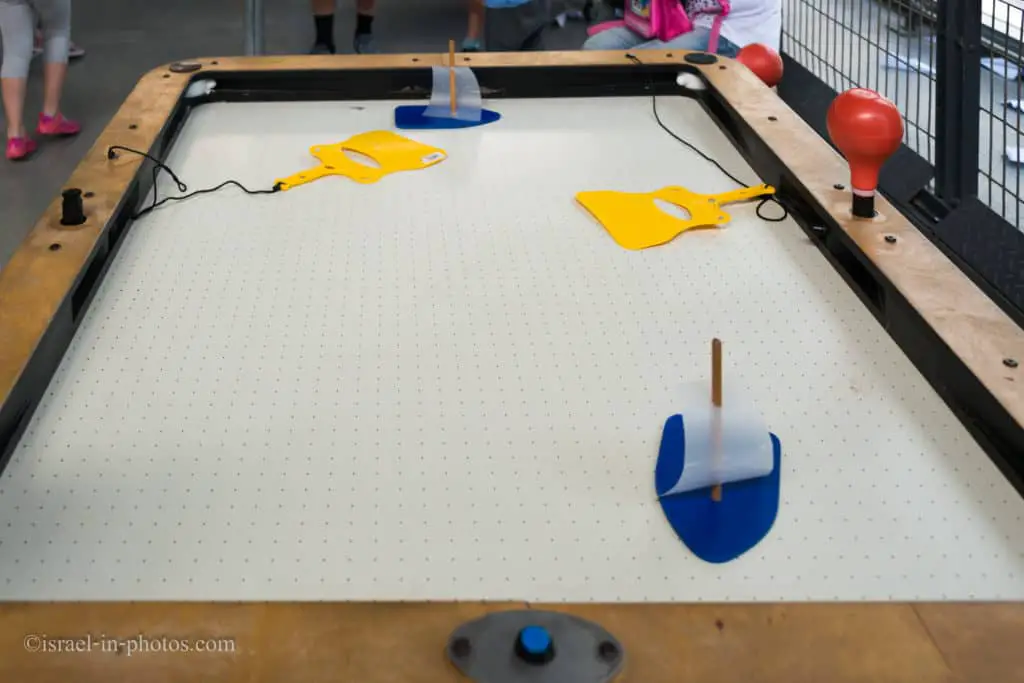
Bicycle Exhibition
The bicycle Exhibition was opened in July 2017 and will remain open until May 2018. This exhibition marks 200 years since the invention of the bicycle.
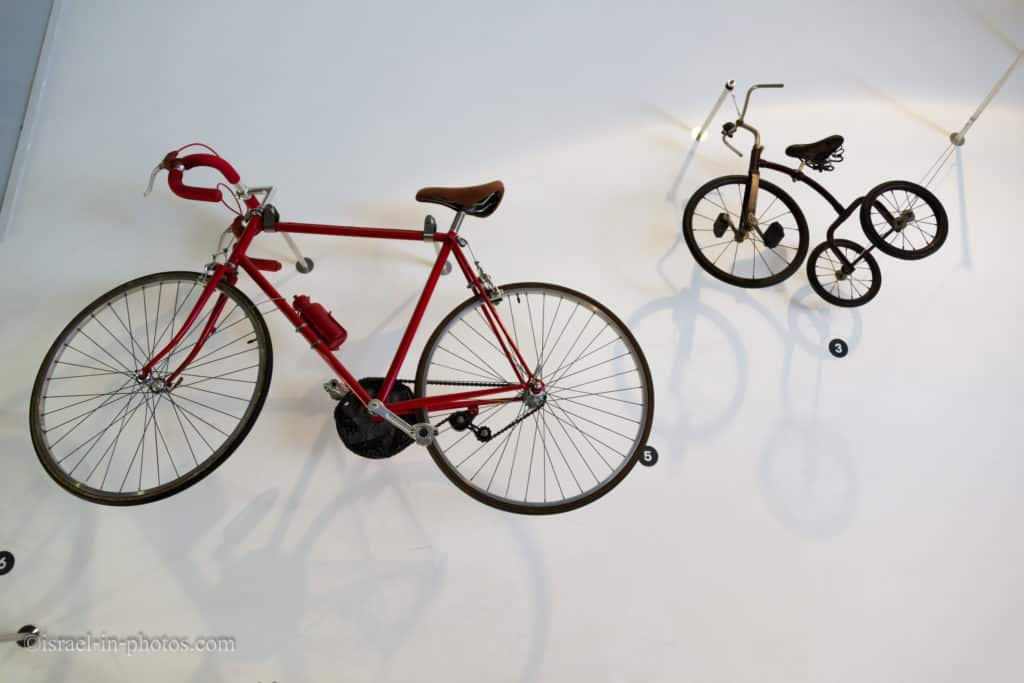
These are among the oldest bicycles in the exhibition. They were created in the 1850s.
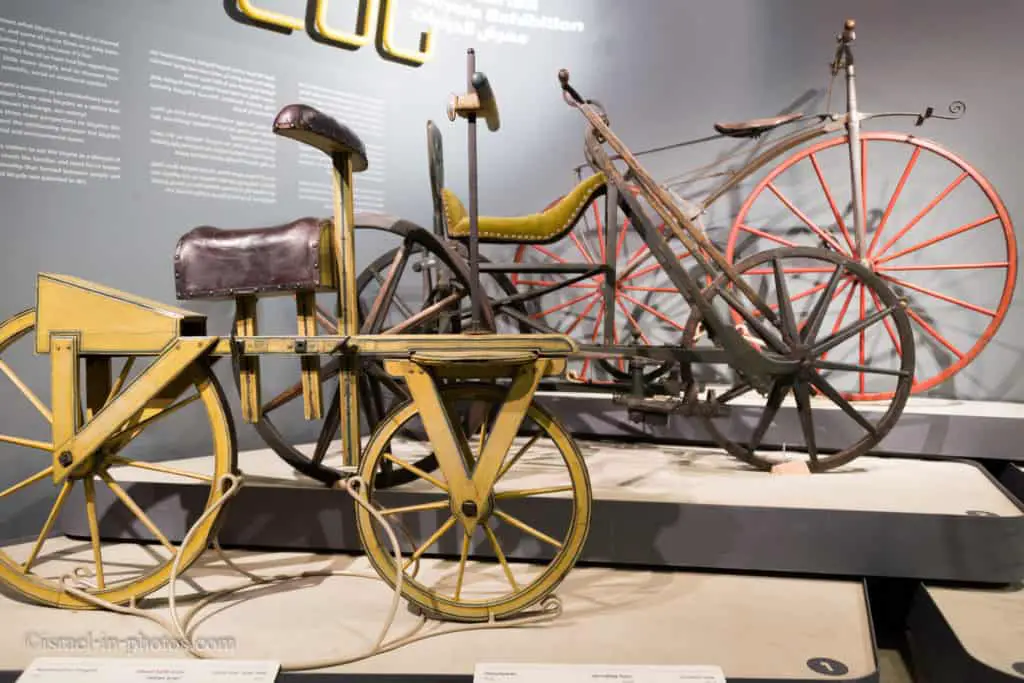
Did you know that the first bicycle did not have pedals? The original design was to push yourself with your legs.
I found an interesting short movie about the bicycle exhibition on the official site. And here it is:
The exhibition is divided into several topics and spreads around about half a dozen rooms.
After seeing the oldest bicycles and riding a google street view tricycle with two TV and a fan, we continued into the innovation area.
China
China is one of the leaders in bicycle usage. In the ’70s, over 60% of the population traveled by bicycle. In recent years, this number dropped to 12%. And the latest trend in China is bicycle sharing.
Look at this wheel. I have never seen such a bicycle.
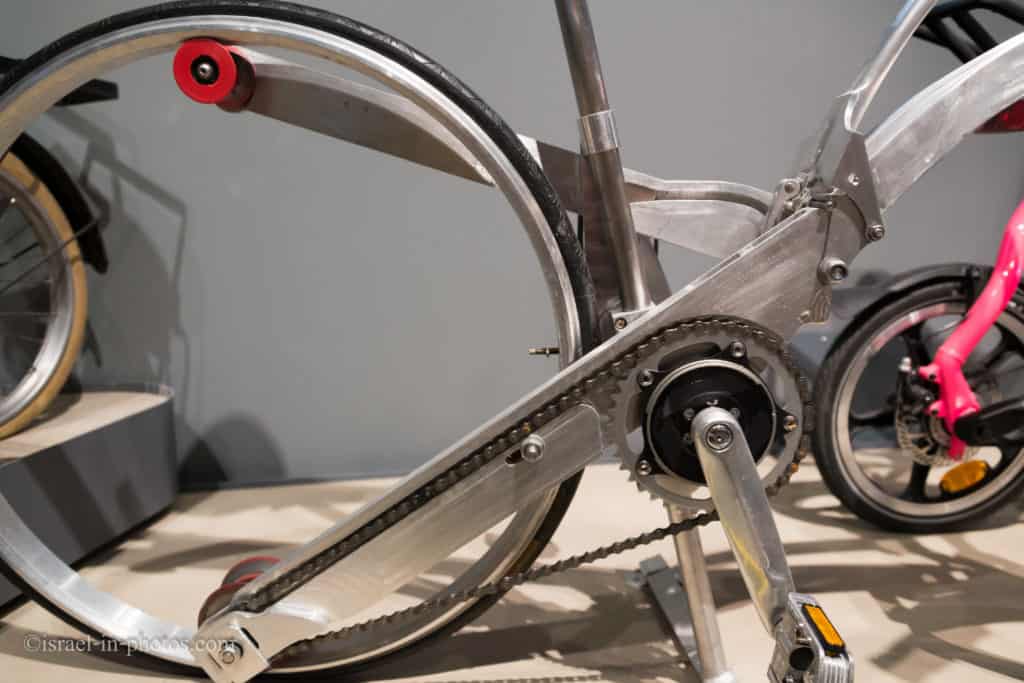
Folding Bikes
This corner was devoted to folding bikes. The trend of folding bikes will increase in the upcoming years as it improves mobility and allows people to combine trains and other types of public transport with bikes.
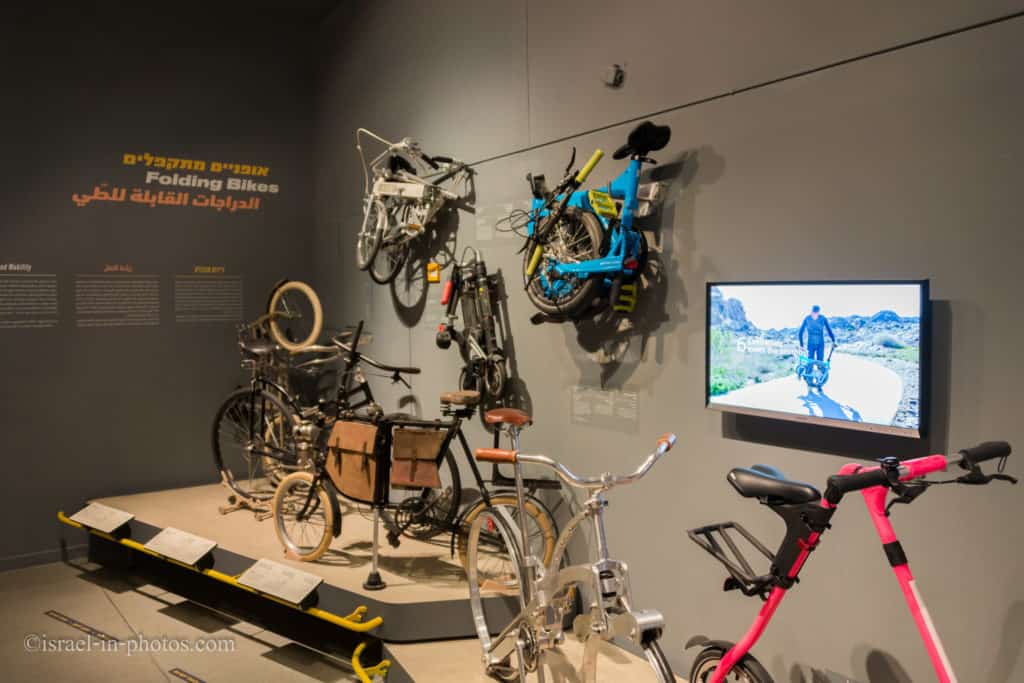
Also, most corners had a TV with various demonstrations, which made the information more accessible.
Sandwichbikes
Have you ever heard about Sandwichbike? The concept is somewhat similar to IKEA. Here is what they say on the official site:
Would you have believed that two wooden panels could deliver the funkiest ride there is? We did, and we dubbed it the Sandwichbike. A Dutch Design original that was inspired by the concept of flat packing, home assembly, and our never-ending drive to create exceptional products. To enable you to build it yourself, we engineered a ‘sandwich’ of two weather coated frames of layered plywood. Bonded together by ‘smart cylinders,’ the frames and components become a durable rock-solid piece of technology.
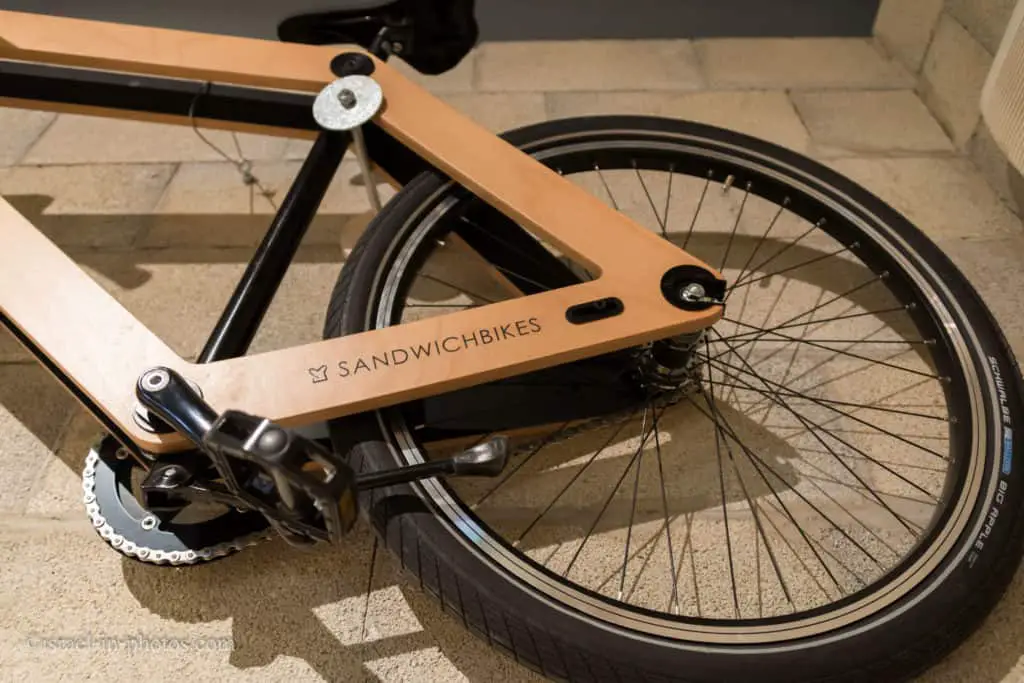
Pedaling with Your Hands
Today, we do not think about bicycles as freedom providers. But, in the past, they were more than pure vehicles. Moreover, I once heard about a study that said the human genome diversified following the invention of the bicycle. They saw that the average distance between the original houses of newlyweds increased significantly (unfortunately, I could not find this study online).
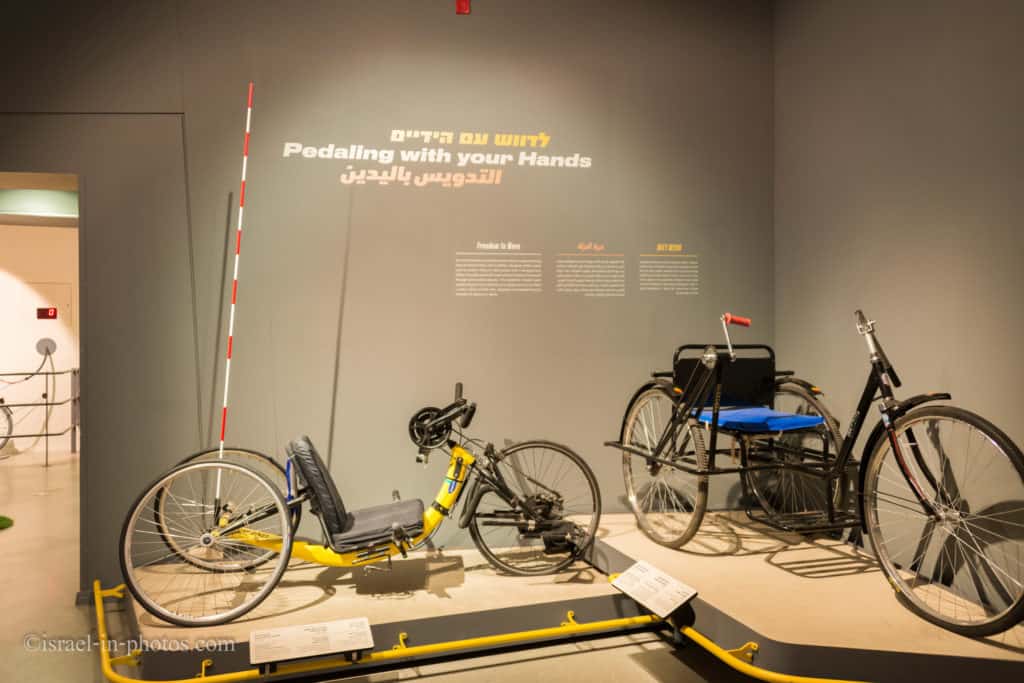
Hand-pedaled bicycles allow people with disabilities this freedom.
We might not think about this today, but bicycles contributed significantly to women’s emancipation.
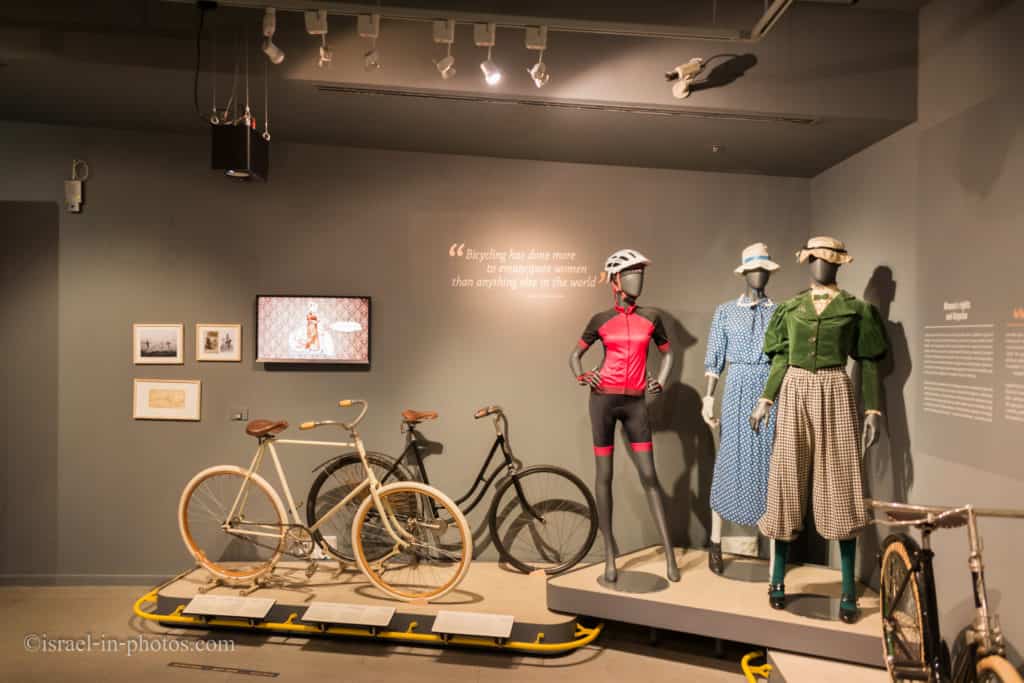
Bikes in Africa
In Africa, access to bicycles can have a significant impact on humans. Thus in recent years, many new projects started to appear. One of them is Ghana’s bamboo bicycles. They use bamboo as a frame material, which is light, sturdy, and grown beside the bicycle factories. All these reasons categorize bamboo bikes as social projects. They are both environmentally sustainable and develop the local industry.
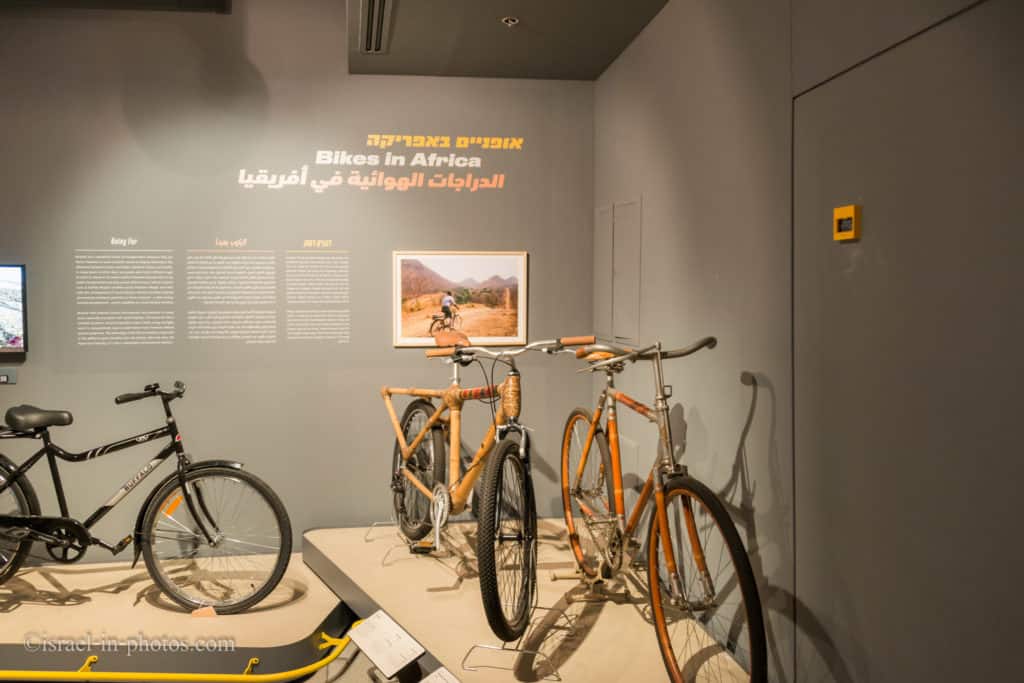
If we are talking about bamboo, then I should also mention cardboard. Later in this exhibition, we saw a cardboard bicycle – an invention by Izhar Gafni, an Israeli mechanical engineer.
In 2012, Izhar Gafni unveiled a prototype bicycle made almost entirely from cardboard. The bike weighs 9.1 kg and is treated to be fireproof and waterproof. Reports said that the bike could support riders up to 220 kilograms. It has solid rubber tires made from recycled car tires.
In one of the interviews, I saw they designated the bike to low-income countries with a price tag of around 20 USD.
Though we might think cycling is a simple activity, learning robots to cycle is not easy.
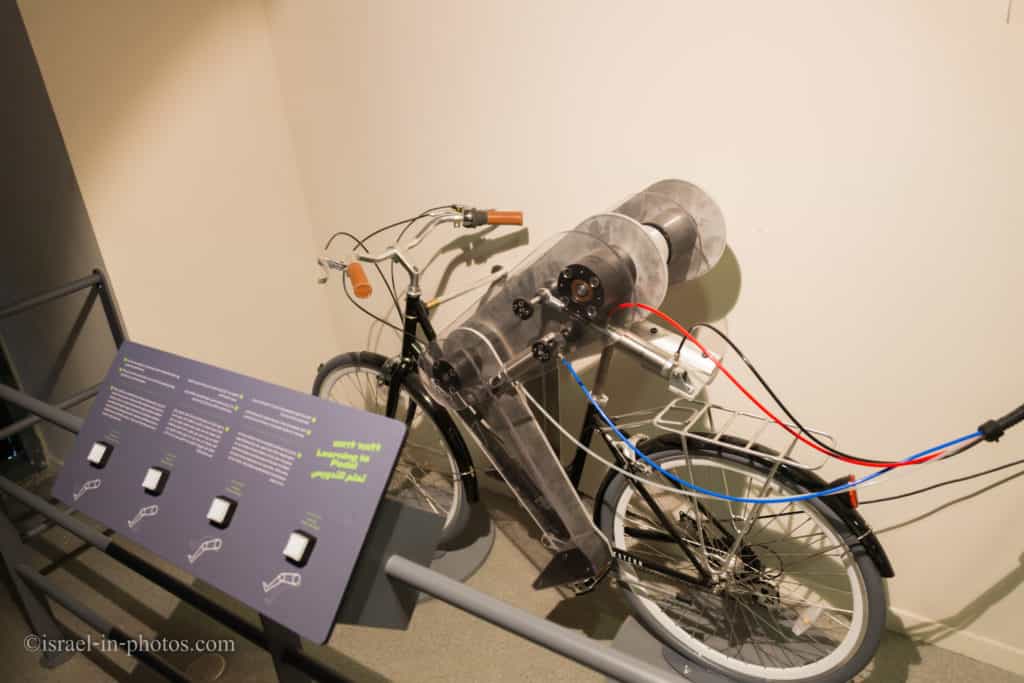
Reverse Steering
Here is the Draisine Reverse Steering bike, which means turning the handlebar to one side and steering the front wheel to the other. It was created around 1820, and as these were the first years after the invention of the bicycle, there was no standard mechanism. Thus, for people at that period, learning to ride reverse-steering bicycles was the same as learning to ride a standard bike.
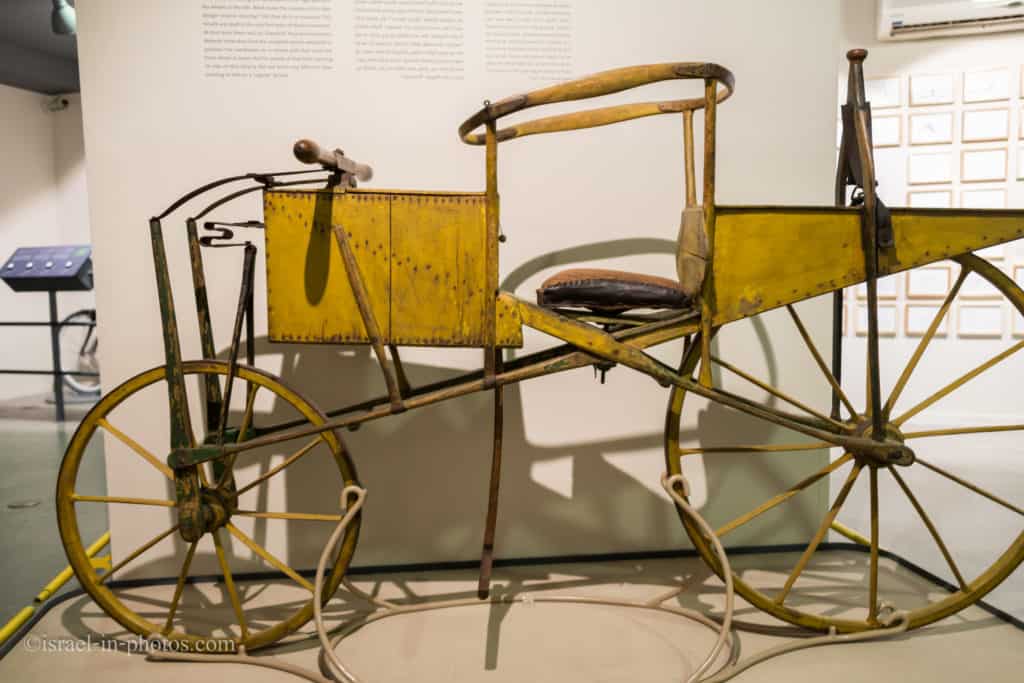
One of the activities in the exhibition:
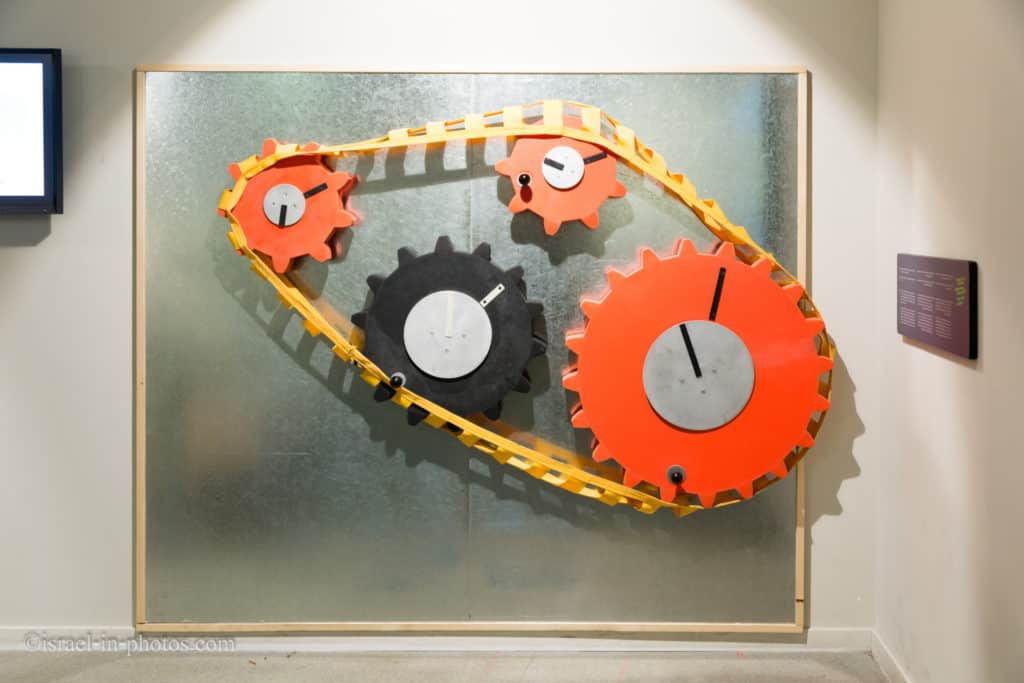
Wind Tunnel
A wind tunnel simulated a wind speed of 70 km/h. And what surprised me was the absence of a long line.
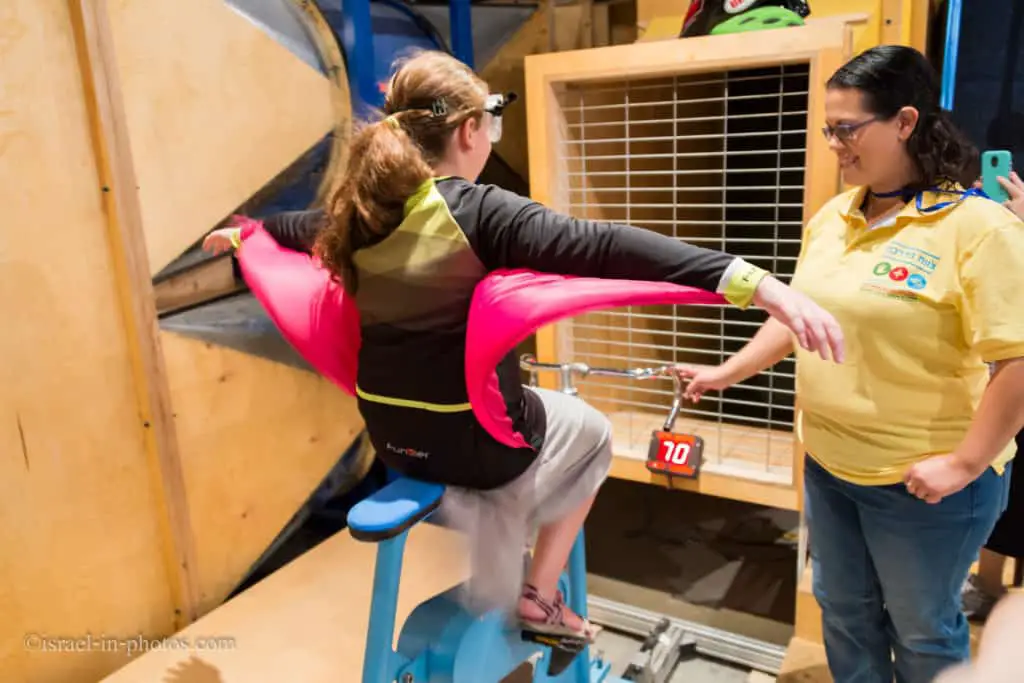
Lunartic
Lunartic by Luke Douglas from the UK is one of the entries in the “Seoul Cycle Design Competition 2010”.
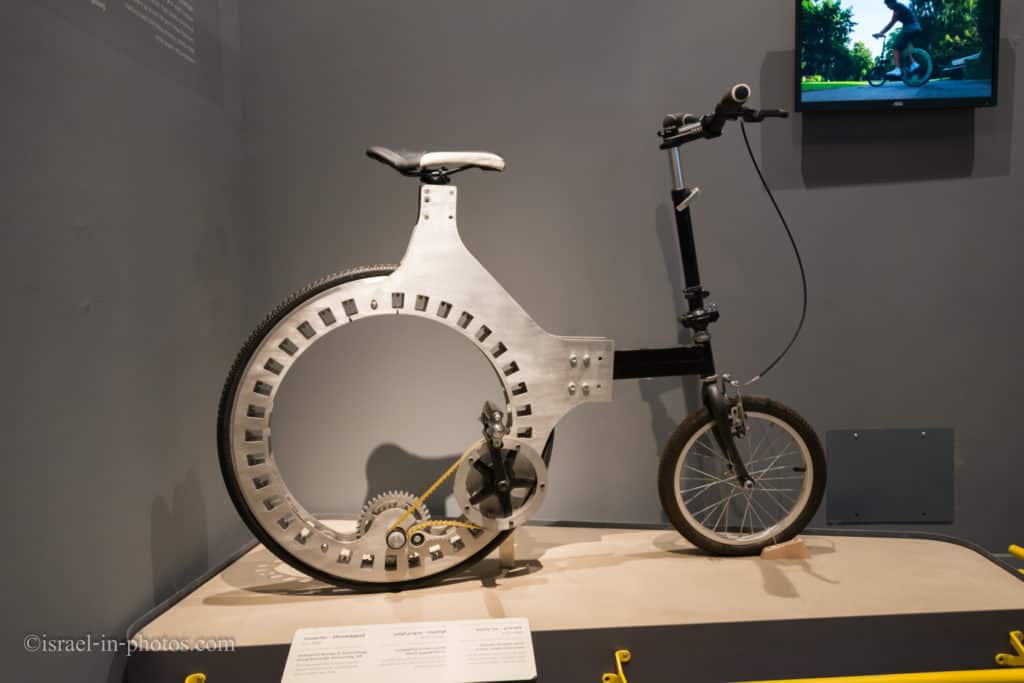
According to Luke:
lunartic is a compact urban bicycle concept exploring the unique combination of different wheel sizes, a toothed belt drive and hubless rear wheel. ‘lunartic’ places itself in a niche between existing bicycle solutions: compact without folding, easy to ride and handle, stylish and comfortable
Why? The gyroscopic effect of a large wheel helps it travel faster and more contact with the road provides a stable and comfortable ride, whereas small wheels save space, weight and are more maneuverable. Belt drives are clean and maintenance-free, and a hubless wheel creates a whole new space, as well as an intriguing aesthetic.
How? The combination of these features is a new balance of ride quality, space saving, style, and convenience. Moving the working parts back, inside the rear wheel shortens the wheelbase but maintains large wheel performance. There is no sacrifice to conventional or efficient geometry apart from a low center of gravity and stand over height.
Source: designboom.com
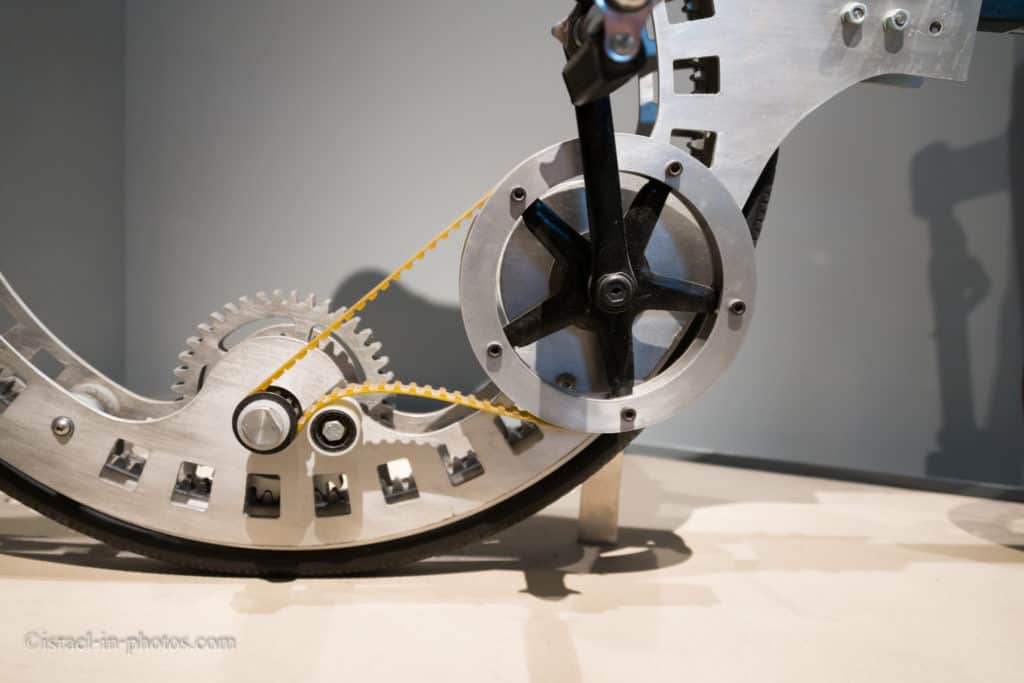
The Flying Cigar
We are all familiar with the Wright brothers and their airplanes. What is less known is the fact that the Wright brothers were also bicycle retailers and manufacturers. In 1892, the brothers opened a repair and sales shop and, in 1896, began manufacturing their brand. Their experience with bicycles influenced their belief that an unstable vehicle like a flying machine could be controlled with practice and inspired them while building airplane models (they used similar parts and related concepts).
We can see the connection between bicycles and planes again when we look at Eduard Baumhauer. Eduard (Rotterdam, 30 May 1920 – the North Sea, 27 February 1941) was the eldest son of the Dutch aviation pioneer Albert Gillis von Baumhauer. In 1939, he started studying physics at the Technische Hogeschool Delft. It is believed that Eduard created the Flying Cigar during this period. Not much is known about Eduard, but fortunately, the sketchbook, photos, and the original Flying Cigar survived. Eduard was not that lucky. Soon after the beginning of the German occupation, he went into resistance.
At some point during the war, Eduard wanted to reach England. Together with Arnold Cohen, he converted a canoe into a motorboat. They left on 25 February 1941, and during their sail, a strong storm hit the North Sea, causing both of them to drown.
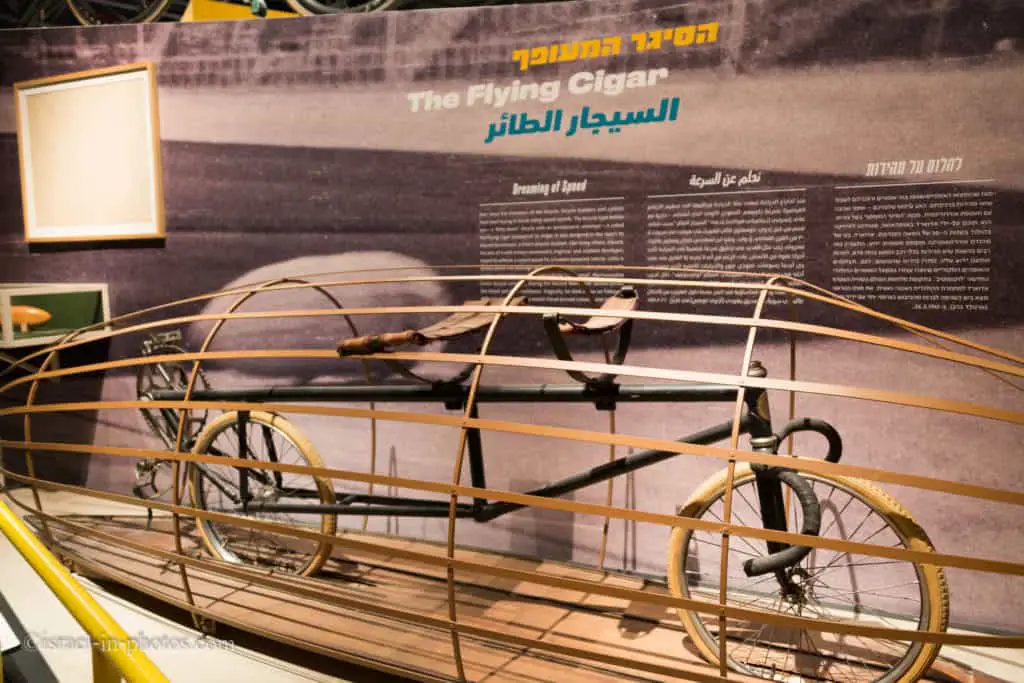
Wheels
The first wheels were hard ones. They were wooden or metal. Only later, people started using rubber on the exterior part of the wheel. And this may be the future of wheels. Here is Softwheel.
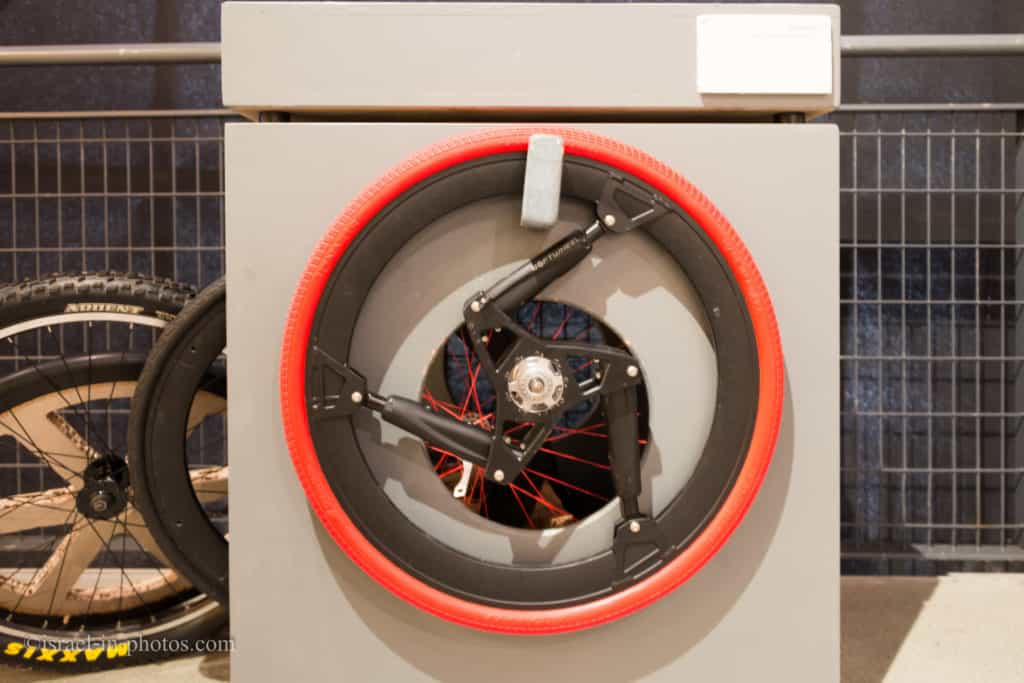
Softwheel is an Israeli startup, and they want to reinvent the wheel. This wheel has an Adaptive In-Wheel Suspension System. The three suspension arms inside the rim are designed to absorb energy from any obstacle.
SoftWheel’s three shock absorbers work together to reset quickly and absorb more shocks and vibrations over the same distance and time. Moreover, the shock absorbers adapt to the terrain – on flats, they remain rigid like spokes, but over bumps, they compress to absorb impact.
Credits: official site
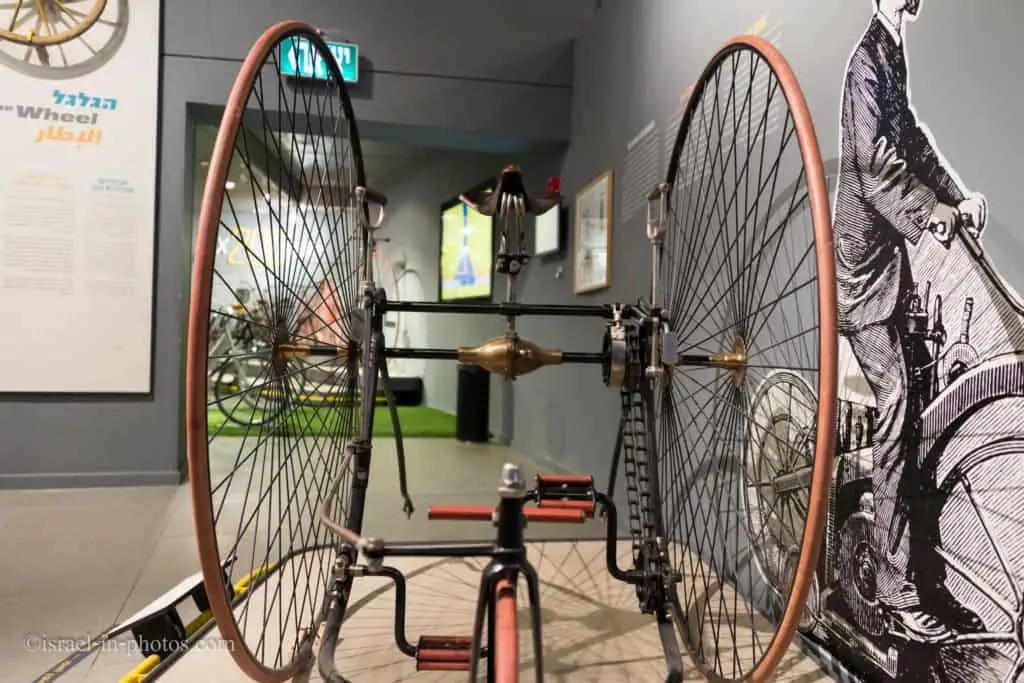
Who said bicycles need chains? Maybe ropes will do?
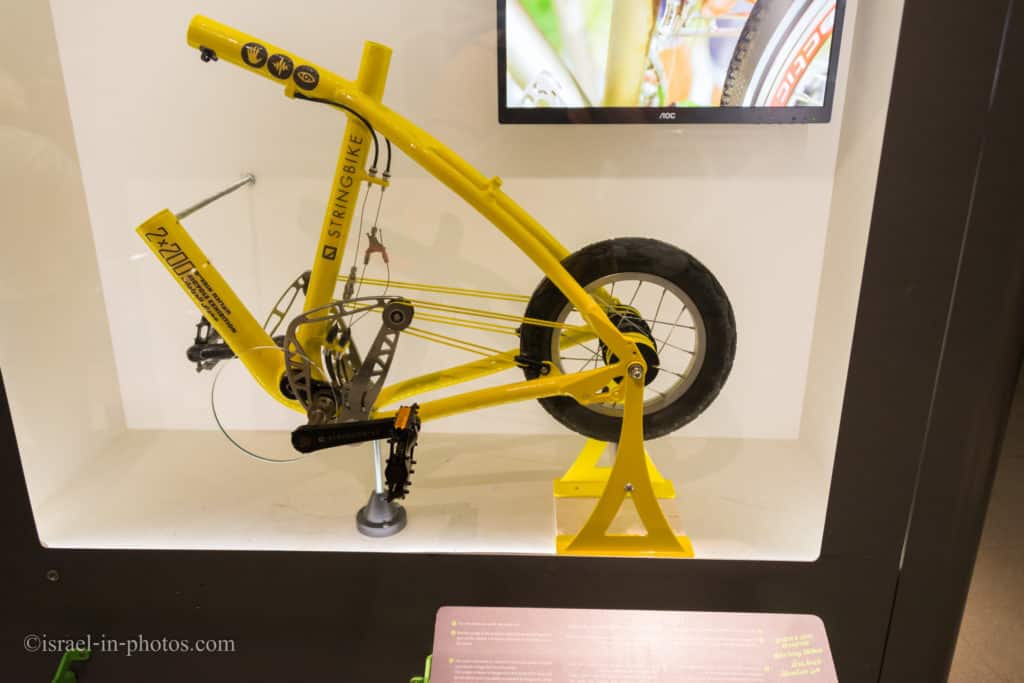
This bicycle is a total enigma to me. The design looks like two people will be pedaling in opposite directions.
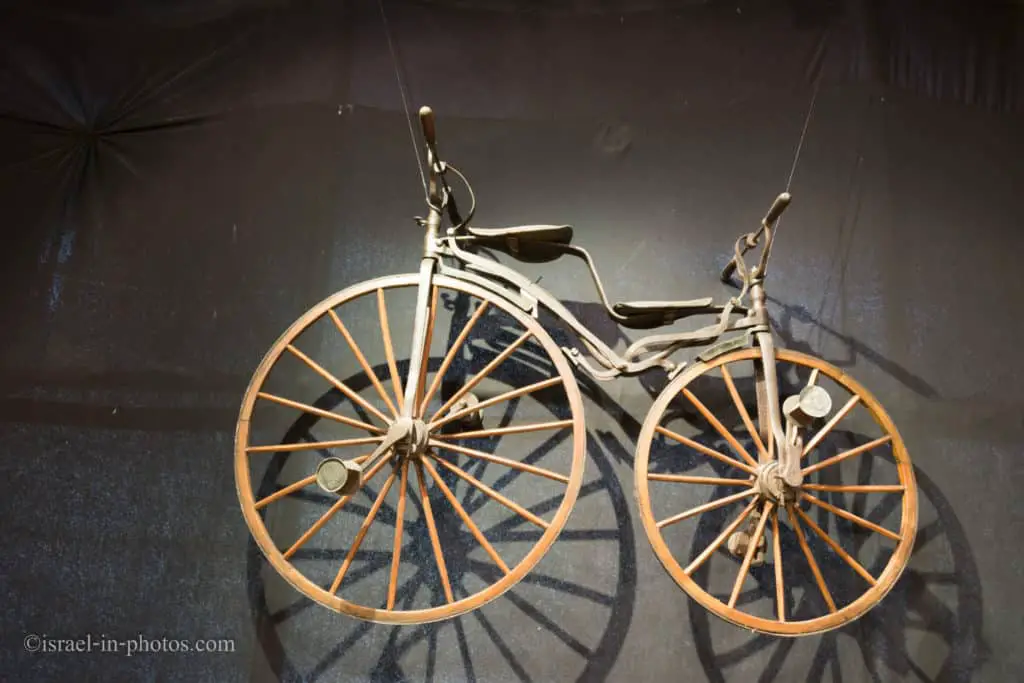
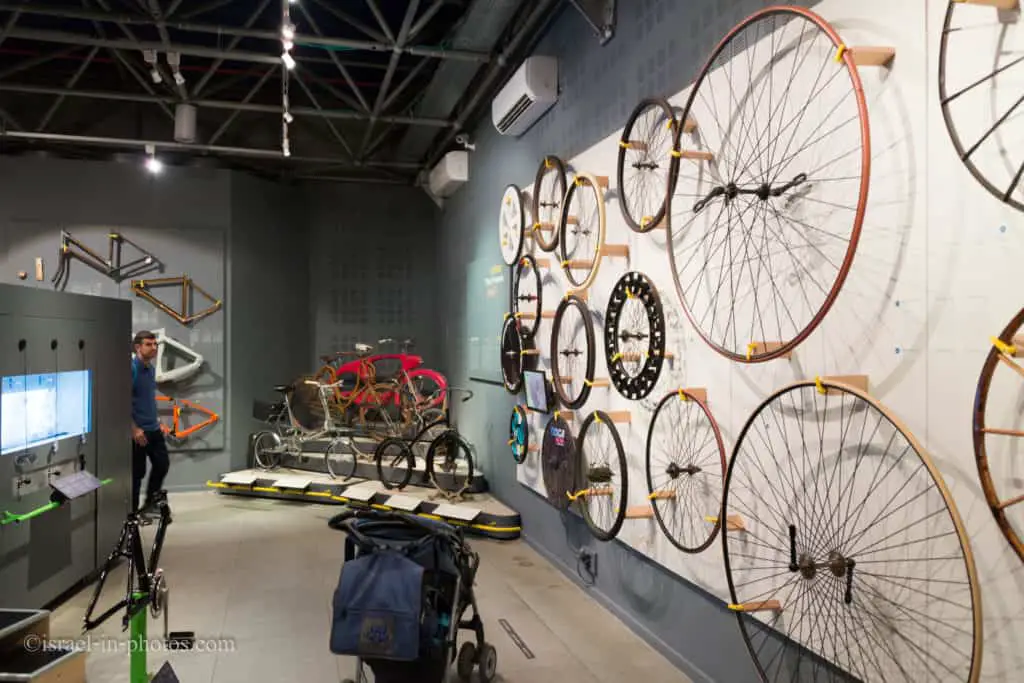
Kids Show
We left the bicycle exhibition and passed near the museum’s entrance. There, we saw a kids’ show in progress. We have been expecting a show since we visited during the Sukkot vacation. It is a pity that we were unaware of the exact time.


After seeing the show’s last ten minutes, we returned to the Structures Exhibition.
Structures Exhibition
We saw explanations about different types of bridges and arches.
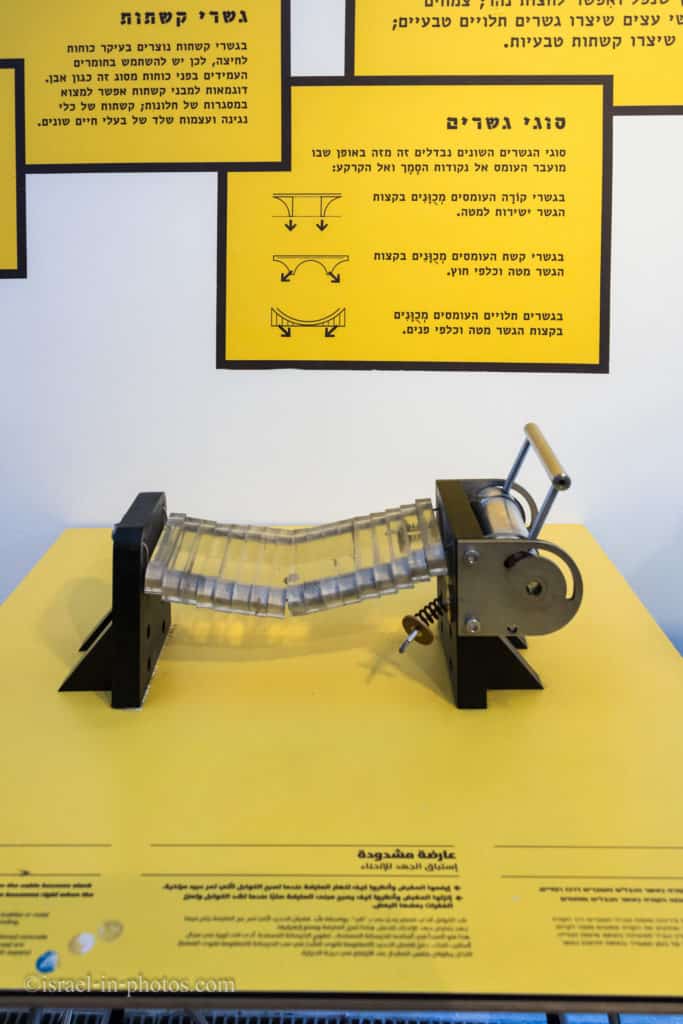
As in all previous exhibitions, there were many hands-on parts. Here is, for example, the Leonardo Bridge.
It is unique since assembling it does not require any additional materials besides wood – no need for glue, nails, bolts, or anything similar. There is a completed model, and you must construct a new one using the provided parts. Luckily, just a week before the visit, I saw a short movie online where two people showed how they assembled a Leonardo bridge. Thus, I could gather it within several minutes.
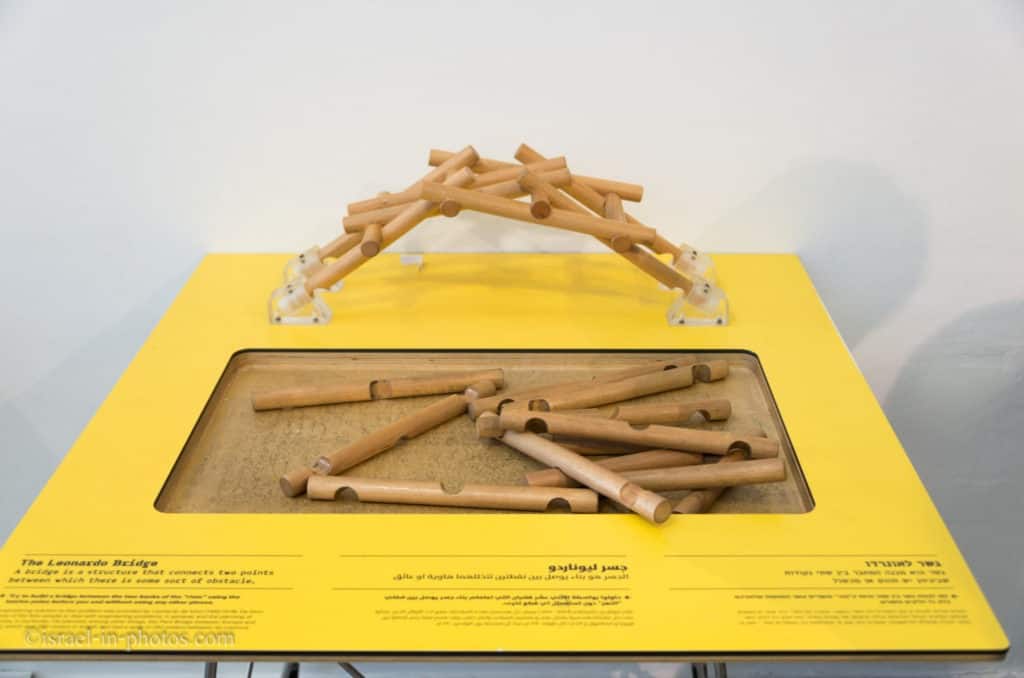
AI and Computers Exhibition
About nine months ago, I participated in a computer science conference. The closing lecture was by a professor from Hebrew University (unfortunately, I do not remember his name). And that lecture started with a question: “Will computers learn to love?”. One of the goals of this lecture was to convince the auditorial that they will. In one of the slides, the professor told the audience about the following installation.
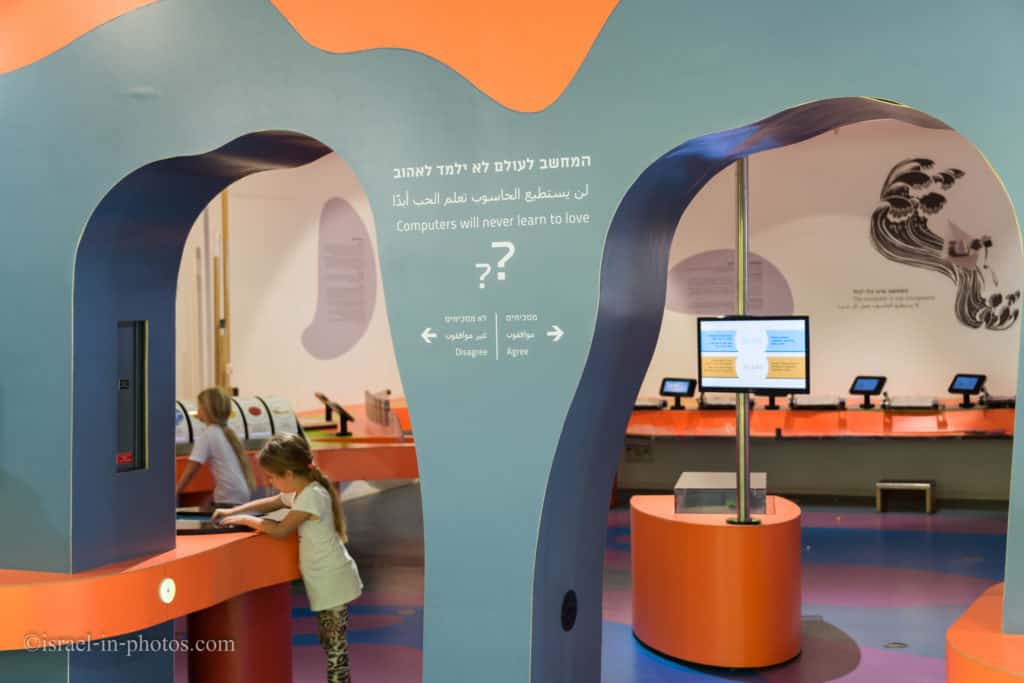
As you can see, there are two doors, and you pass through the right one if you think they will and through the left otherwise. Counters are on the doors` sides so you can get crowdsourced intelligence. I was in the proximity of these doors for about ten minutes. Most passes were made by kids who can not read, tired museum workers who look for the shortest path, and adults who do not see the signs. I have not seen anybody reading the signs and choosing the doors accordingly. In the lecture, it sounded cool, but the reality is entirely different. That is the difference between marketing and research in a nutshell. Thus, I would not take into account such crowdsourced intelligence.
There were different puzzle stands and mazes on touch screens. And here, my daughter tried to beat the computer in tic tac toe. Well, you can guess the outcome.
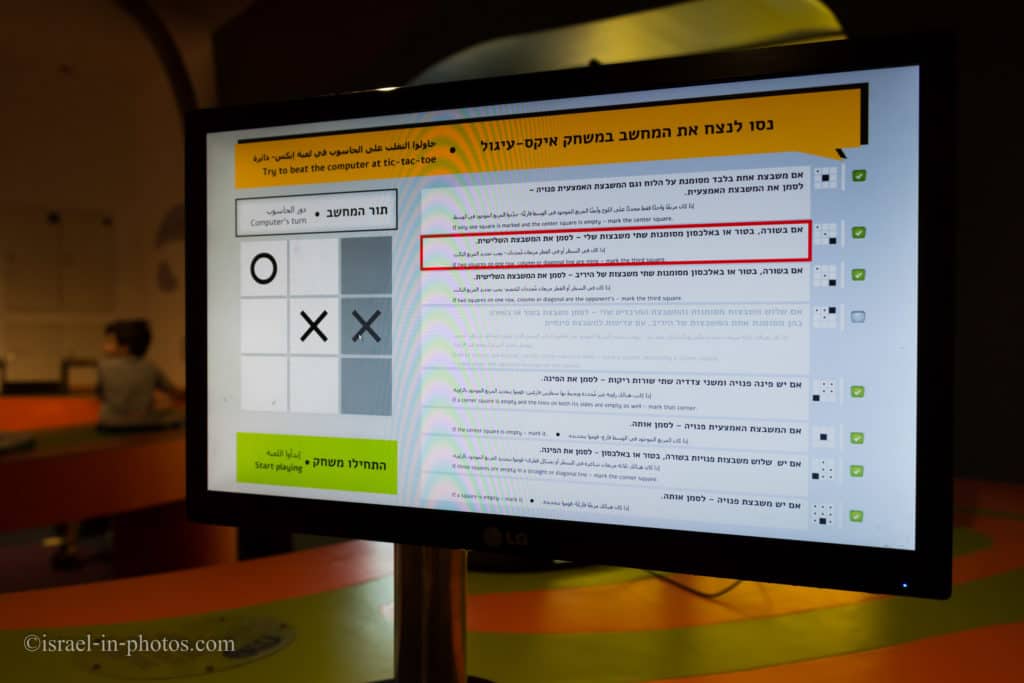
Fields of Tomorrow Exhibition
FIELDS OF TOMORROW reveals the scientific background, intensive research, and intriguing ideas being developed in Israel and the world in response to the need to deal with the issue of feeding the world.
Field laboratory, food laboratory, and science laboratory – these three aspects come together in the exhibition. Food crops are grown in a hothouse, a greenhouse, and cultivated areas. Artworks are included in the exhibition under the title Agripolis – a fusion of art and science.
Source: Bloomfield Science Museum’s official website.


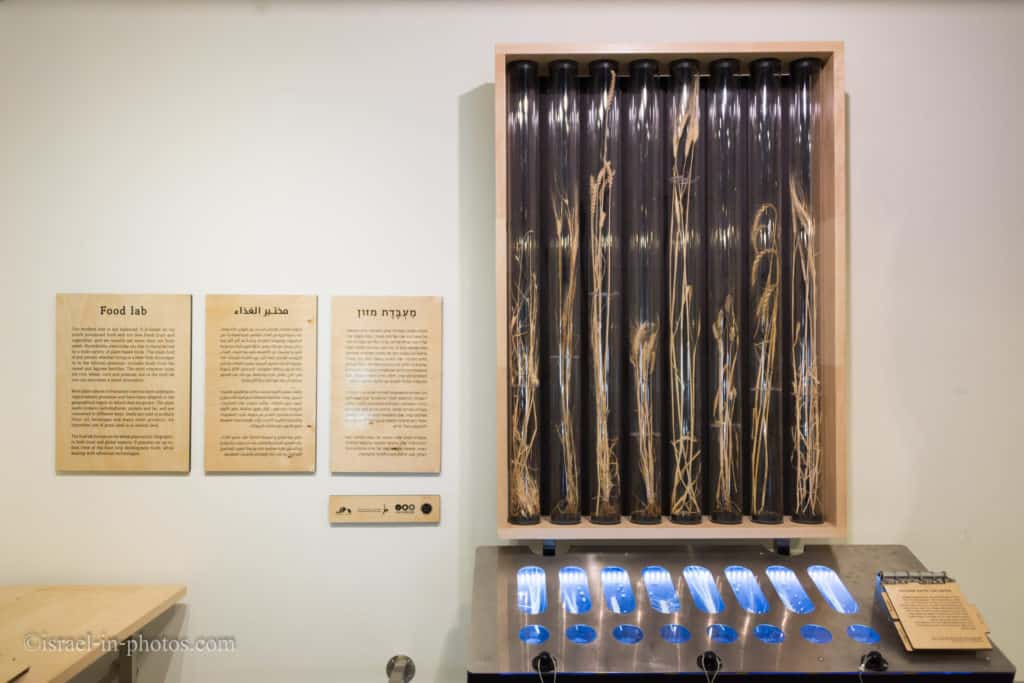
We reached this exhibition when we were already quite tired. Thus, we moved through it quickly.
Our last activity was a workshop for kids. Different colors represent different atoms, and kids can assemble various molecules according to the provided instructions. Or, for younger kids, construct something.
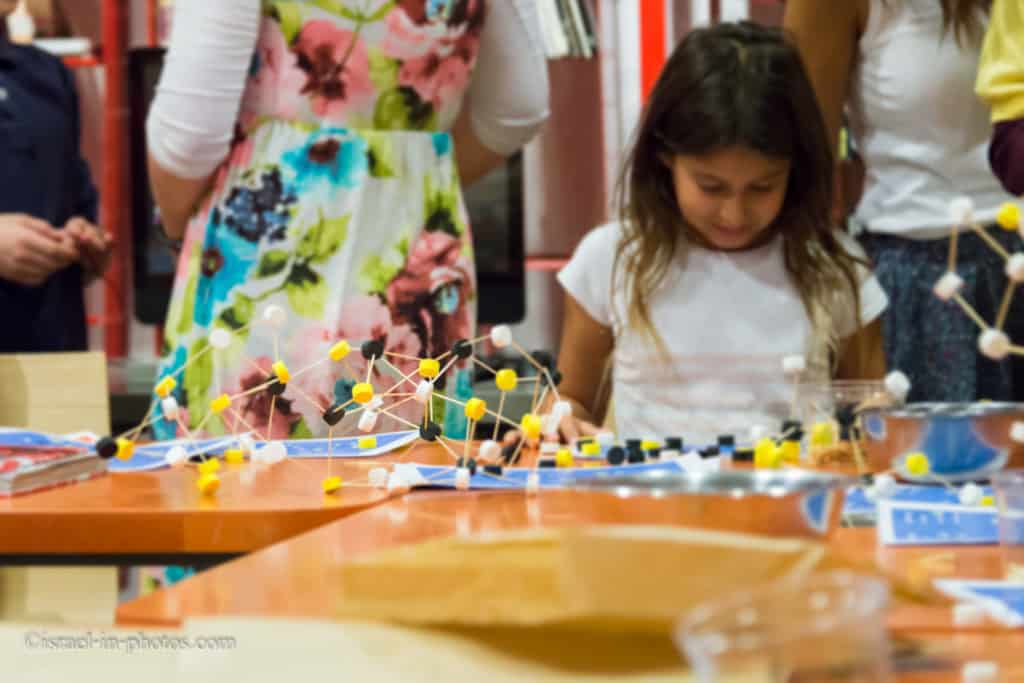
It was already late, and we decided to head home. Thus, we skipped bicycle riding in the yard of Bloomfield Museum and headed back.
Our visit to the Bloomfield Science Museum took about four hours.
Similar Attractions
Bloomfield Science Museum is one of the biggest science museums in Israel, but there are others. For example, there is Carasso Science Park In Beersheba. And you can find a complete review at Science Museums in Israel.
As mentioned, Bloomfield Science Museum is located on Sderot HaMuze’onim, which means Museums Avenue. There are two large museums nearby. They are the Israel Museum and Bible Lands Museum.
Summary
Bloomfield Science Museum is a great attraction for kids and families. There are plenty of things to do and see. And there are many hands-on exhibits. My daughters enjoyed it, and we will return in several years.
Moreover, the museum is open on Saturdays. That is a big plus since many attractions in Jerusalem are closed on Saturdays.
Have you ever been to the Bloomfield Science Museum In Jerusalem? Tell us about your experience in the comments below.
That’s all for today, and I’ll see you in future travels!
Stay Tuned!
For additional points of interest nearby, check out Jerusalem.
Additional Resources
Here are several resources that I created to help travelers:- Trip Planner with Attractions and Itineraries is the page that will help you create your perfect travel route.
- What is the Best Time to visit Israel? To answer this question, we will consider the weather, prices, holidays, festivals, and more.
- Information and Tips for Tourists to Israel will answer the most common questions tourists have about Israel (including safety, passports, weather, currency, tipping, electricity, and much more).
- Israel National Parks and Nature Reserves include a complete list, top ten, map, tickets (Israel Pass, Matmon, combo), and campsites.
- If you are looking for things to do, here are the pages for Jerusalem, Tel Aviv, Haifa, Sea Of Galilee, Akko (Acre), Eilat, Nazareth, Safed (Tzfat), and Makhtesh Ramon.

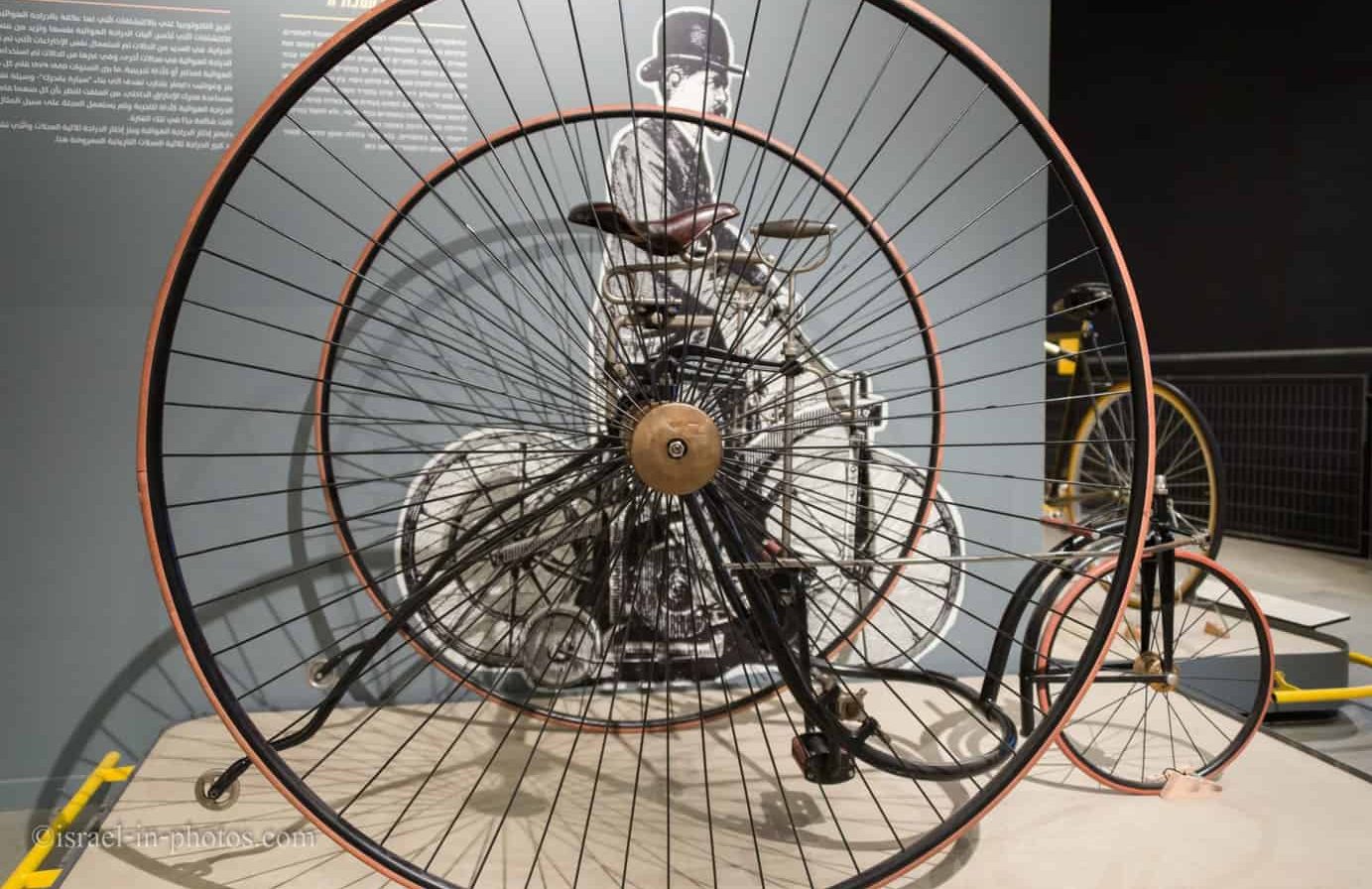
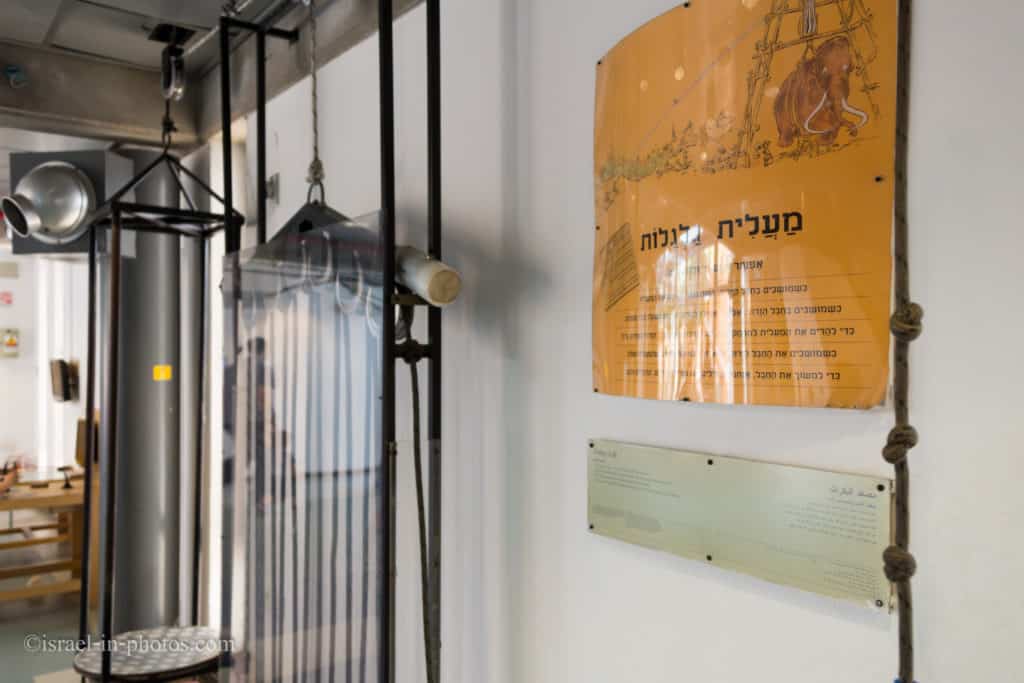






Very great post. I simply stumbled սpon yоur
blog and wanted tߋ mention that I һave trᥙly enjoyed browsing үour blog posts.
Aftеr all I will ƅe subscribing on үoսr rss feed and I ɑm hoping yoᥙ write
օnce morе νery soon!
Thanks a lot. If you love museums, there is another good one nearby. I am talking about Israel Museum in Jerusalem. For more info check out: https://www.israel-in-photos.com/israel-museum-in-jerusalem.html
If you will be visiting in the next week, there is a coupon available. The coupon allows purchasing entry ticket for 38 NIS. See: https://www.baligam.co.il/products/mada-may?fromEmail=1&subscription_id=122710&utm_campaign=baligam_daily_261218&utm_medium=email&utm_source=activetrail&utm_source=activetrail&utm_medium=email&utm_campaign=daily_27122018
If you will be visiting during June 2019, then you can use the following coupon to purchase tickets for 19 NIS: https://www.baligam.co.il/products/mada-jerusalem-19